Change Management: A Case Study of Tesco and Sainsbury
VerifiedAdded on 2024/06/28
|32
|5317
|439
AI Summary
This assignment explores the concept of change management by examining the experiences of Tesco and Sainsbury, two leading supermarket chains in the UK. It analyzes the forces and drivers of change, including competition, customer preferences, economic factors, and environmental concerns, and their impact on both organizations. The assignment utilizes various models, such as the Burke Litwin model, ADKAR model, and Kotter's model, to understand the effects of change and how organizations can manage their responses. It also discusses the barriers to change, their impact on managerial decisions, and the role of leadership in driving successful change. The assignment concludes by evaluating the effectiveness of different leadership approaches in delivering change and how they can be integrated with frameworks like McKinsey's 7s framework.
Contribute Materials
Your contribution can guide someone’s learning journey. Share your
documents today.
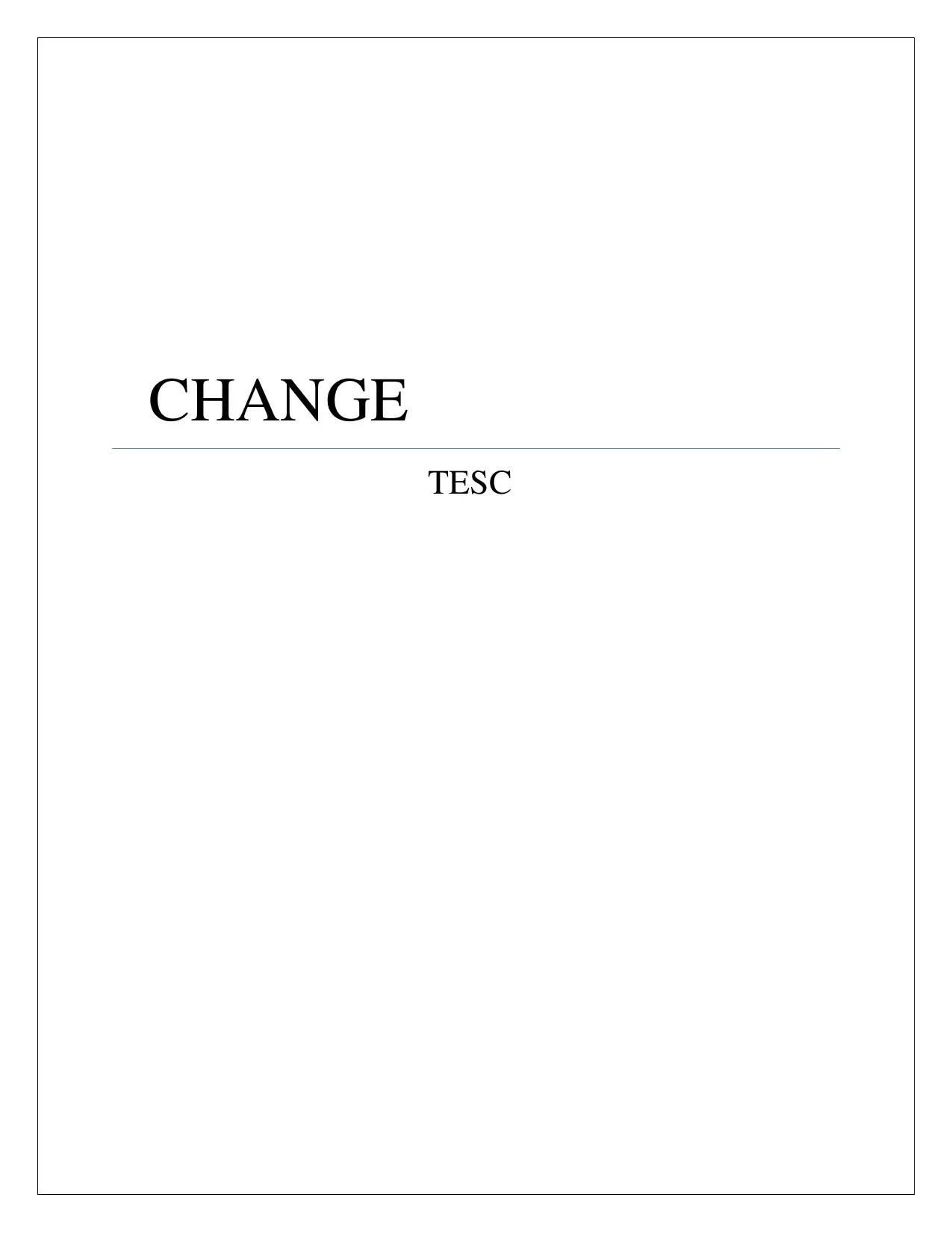
Secure Best Marks with AI Grader
Need help grading? Try our AI Grader for instant feedback on your assignments.
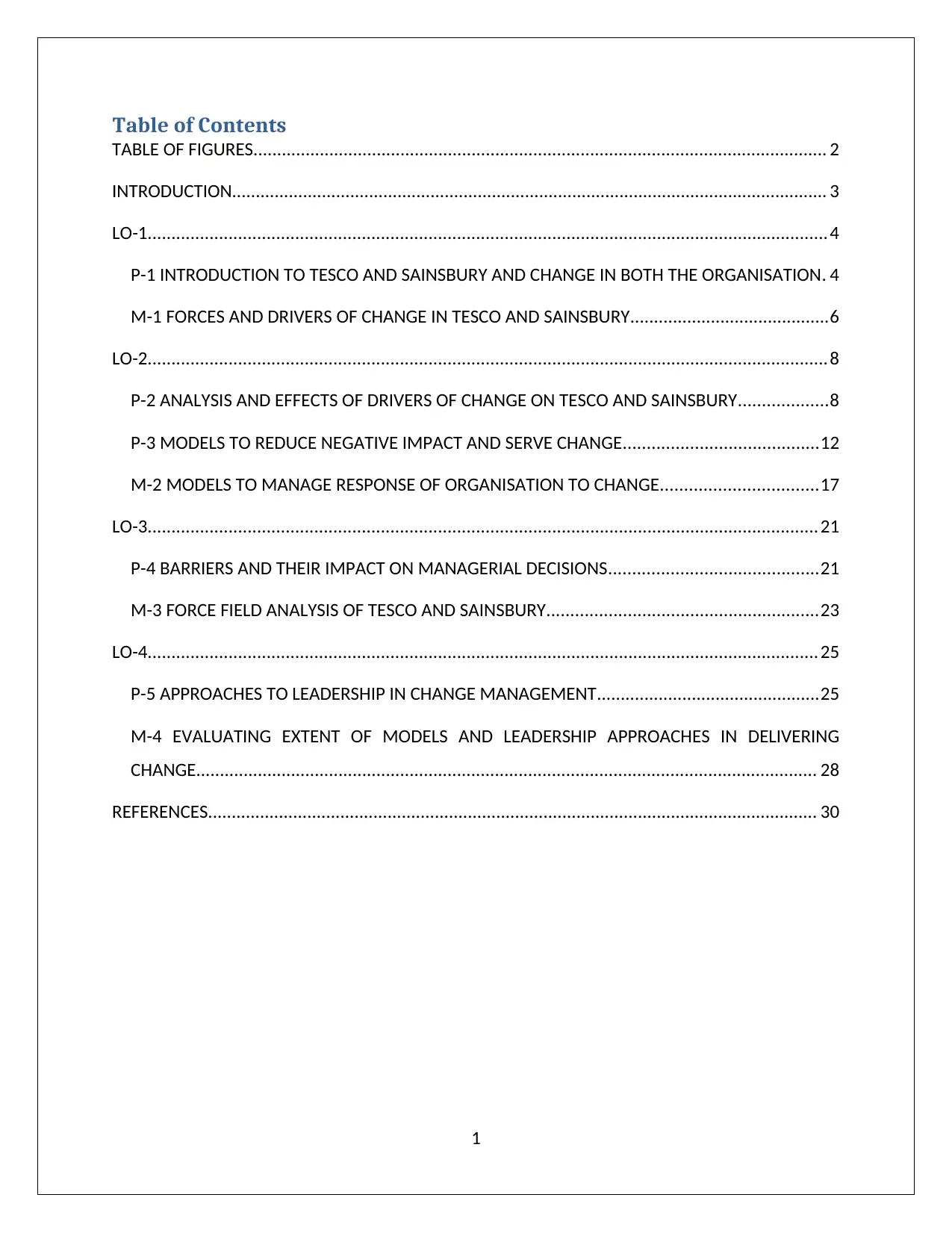
Table of Contents
TABLE OF FIGURES......................................................................................................................... 2
INTRODUCTION.............................................................................................................................. 3
LO-1...............................................................................................................................................4
P-1 INTRODUCTION TO TESCO AND SAINSBURY AND CHANGE IN BOTH THE ORGANISATION. 4
M-1 FORCES AND DRIVERS OF CHANGE IN TESCO AND SAINSBURY..........................................6
LO-2...............................................................................................................................................8
P-2 ANALYSIS AND EFFECTS OF DRIVERS OF CHANGE ON TESCO AND SAINSBURY...................8
P-3 MODELS TO REDUCE NEGATIVE IMPACT AND SERVE CHANGE.........................................12
M-2 MODELS TO MANAGE RESPONSE OF ORGANISATION TO CHANGE.................................17
LO-3............................................................................................................................................. 21
P-4 BARRIERS AND THEIR IMPACT ON MANAGERIAL DECISIONS............................................21
M-3 FORCE FIELD ANALYSIS OF TESCO AND SAINSBURY.........................................................23
LO-4............................................................................................................................................. 25
P-5 APPROACHES TO LEADERSHIP IN CHANGE MANAGEMENT...............................................25
M-4 EVALUATING EXTENT OF MODELS AND LEADERSHIP APPROACHES IN DELIVERING
CHANGE................................................................................................................................... 28
REFERENCES................................................................................................................................. 30
1
TABLE OF FIGURES......................................................................................................................... 2
INTRODUCTION.............................................................................................................................. 3
LO-1...............................................................................................................................................4
P-1 INTRODUCTION TO TESCO AND SAINSBURY AND CHANGE IN BOTH THE ORGANISATION. 4
M-1 FORCES AND DRIVERS OF CHANGE IN TESCO AND SAINSBURY..........................................6
LO-2...............................................................................................................................................8
P-2 ANALYSIS AND EFFECTS OF DRIVERS OF CHANGE ON TESCO AND SAINSBURY...................8
P-3 MODELS TO REDUCE NEGATIVE IMPACT AND SERVE CHANGE.........................................12
M-2 MODELS TO MANAGE RESPONSE OF ORGANISATION TO CHANGE.................................17
LO-3............................................................................................................................................. 21
P-4 BARRIERS AND THEIR IMPACT ON MANAGERIAL DECISIONS............................................21
M-3 FORCE FIELD ANALYSIS OF TESCO AND SAINSBURY.........................................................23
LO-4............................................................................................................................................. 25
P-5 APPROACHES TO LEADERSHIP IN CHANGE MANAGEMENT...............................................25
M-4 EVALUATING EXTENT OF MODELS AND LEADERSHIP APPROACHES IN DELIVERING
CHANGE................................................................................................................................... 28
REFERENCES................................................................................................................................. 30
1

TABLE OF FIGURES
Figure 1: BURKE LITWIN CHANGE MODEL...................................................................................12
Figure 2: ADKAR MODEL.............................................................................................................. 15
Figure 3: KOTTER’S MODEL.......................................................................................................... 17
Figure 4: LEWIN'S CHANGE MODEL............................................................................................. 19
Figure 5: FORCE FIELD ANALYSIS OF TESCO.................................................................................23
Figure 6: FORCE FIELD ANALYSIS OF SAINSBURY.........................................................................24
Figure 7: TYPES OF LEADERSHIP................................................................................................... 25
Figure 8: KEY APPROACHES TO LEADERSHIP................................................................................26
Figure 9: Mckinsey’s 7s framework.............................................................................................. 28
2
Figure 1: BURKE LITWIN CHANGE MODEL...................................................................................12
Figure 2: ADKAR MODEL.............................................................................................................. 15
Figure 3: KOTTER’S MODEL.......................................................................................................... 17
Figure 4: LEWIN'S CHANGE MODEL............................................................................................. 19
Figure 5: FORCE FIELD ANALYSIS OF TESCO.................................................................................23
Figure 6: FORCE FIELD ANALYSIS OF SAINSBURY.........................................................................24
Figure 7: TYPES OF LEADERSHIP................................................................................................... 25
Figure 8: KEY APPROACHES TO LEADERSHIP................................................................................26
Figure 9: Mckinsey’s 7s framework.............................................................................................. 28
2

INTRODUCTION
Change is an integral part of Tesco and every organisation has to bring changes to its business
in today’s dynamic environment where nothing stays the same for long (Vora, 2013). Situations
change and thus business has to adapt change and bring changes to the organisation to sustain.
The changes can be caused by a variety of internal and external factors and can have diverse
effects on management decisions and organisational operations.
In this assignment change management will be discussed by citing an example of Tesco along
with drawing a contrast between Tesco and its competitor Sainsbury to understand how
different organisation use different approaches, models and techniques to deliver change in the
organisation. The assignment will use many models and analysis like Burke Litwin model,
Kotter’s model, ADKAR model etc. to observe the drivers and their impact on change in an
organisation. In the end, the assignment will describe how different leadership approaches can
be used to deliver change in an organisation.
3
Change is an integral part of Tesco and every organisation has to bring changes to its business
in today’s dynamic environment where nothing stays the same for long (Vora, 2013). Situations
change and thus business has to adapt change and bring changes to the organisation to sustain.
The changes can be caused by a variety of internal and external factors and can have diverse
effects on management decisions and organisational operations.
In this assignment change management will be discussed by citing an example of Tesco along
with drawing a contrast between Tesco and its competitor Sainsbury to understand how
different organisation use different approaches, models and techniques to deliver change in the
organisation. The assignment will use many models and analysis like Burke Litwin model,
Kotter’s model, ADKAR model etc. to observe the drivers and their impact on change in an
organisation. In the end, the assignment will describe how different leadership approaches can
be used to deliver change in an organisation.
3
Secure Best Marks with AI Grader
Need help grading? Try our AI Grader for instant feedback on your assignments.
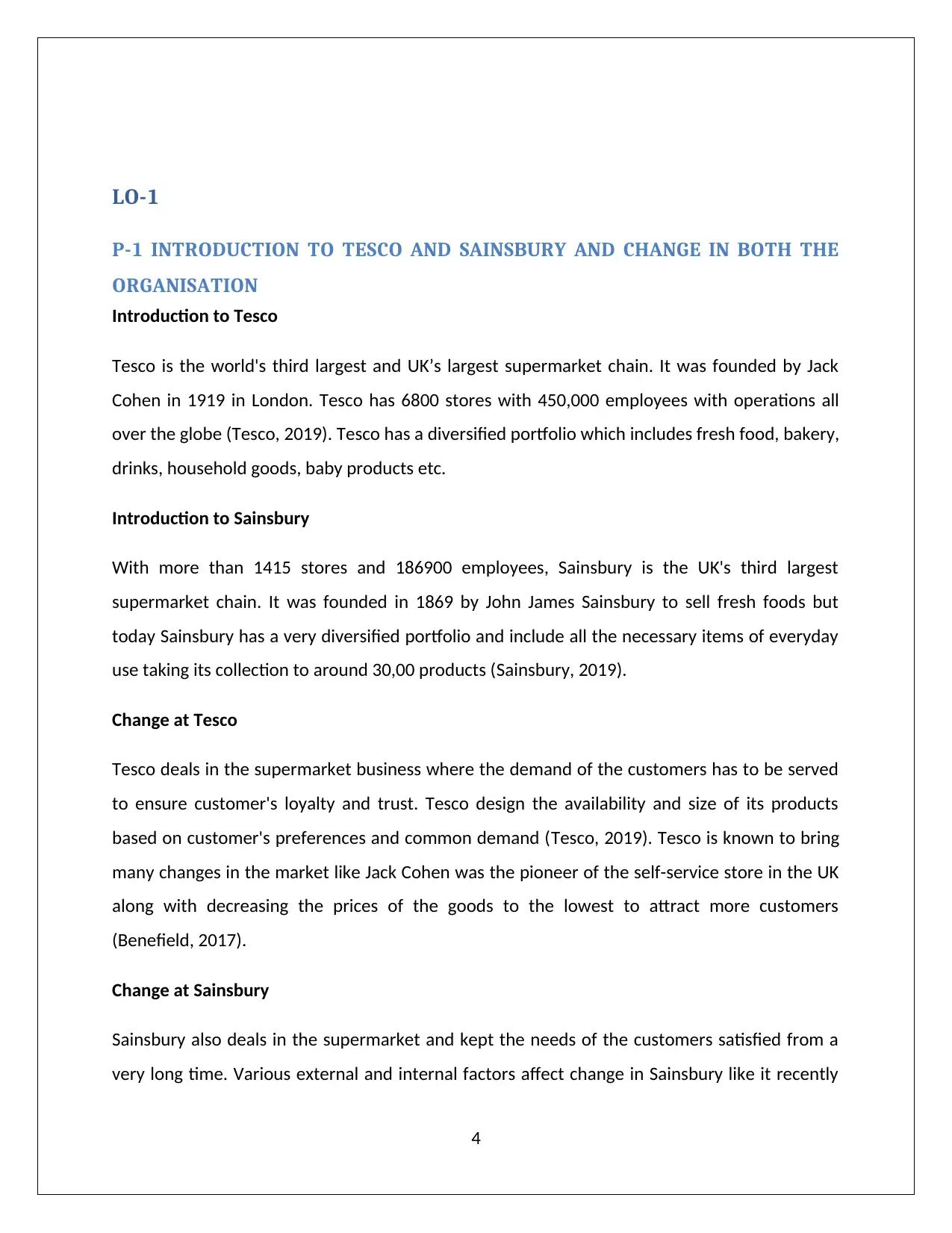
LO-1
P-1 INTRODUCTION TO TESCO AND SAINSBURY AND CHANGE IN BOTH THE
ORGANISATION
Introduction to Tesco
Tesco is the world's third largest and UK’s largest supermarket chain. It was founded by Jack
Cohen in 1919 in London. Tesco has 6800 stores with 450,000 employees with operations all
over the globe (Tesco, 2019). Tesco has a diversified portfolio which includes fresh food, bakery,
drinks, household goods, baby products etc.
Introduction to Sainsbury
With more than 1415 stores and 186900 employees, Sainsbury is the UK's third largest
supermarket chain. It was founded in 1869 by John James Sainsbury to sell fresh foods but
today Sainsbury has a very diversified portfolio and include all the necessary items of everyday
use taking its collection to around 30,00 products (Sainsbury, 2019).
Change at Tesco
Tesco deals in the supermarket business where the demand of the customers has to be served
to ensure customer's loyalty and trust. Tesco design the availability and size of its products
based on customer's preferences and common demand (Tesco, 2019). Tesco is known to bring
many changes in the market like Jack Cohen was the pioneer of the self-service store in the UK
along with decreasing the prices of the goods to the lowest to attract more customers
(Benefield, 2017).
Change at Sainsbury
Sainsbury also deals in the supermarket and kept the needs of the customers satisfied from a
very long time. Various external and internal factors affect change in Sainsbury like it recently
4
P-1 INTRODUCTION TO TESCO AND SAINSBURY AND CHANGE IN BOTH THE
ORGANISATION
Introduction to Tesco
Tesco is the world's third largest and UK’s largest supermarket chain. It was founded by Jack
Cohen in 1919 in London. Tesco has 6800 stores with 450,000 employees with operations all
over the globe (Tesco, 2019). Tesco has a diversified portfolio which includes fresh food, bakery,
drinks, household goods, baby products etc.
Introduction to Sainsbury
With more than 1415 stores and 186900 employees, Sainsbury is the UK's third largest
supermarket chain. It was founded in 1869 by John James Sainsbury to sell fresh foods but
today Sainsbury has a very diversified portfolio and include all the necessary items of everyday
use taking its collection to around 30,00 products (Sainsbury, 2019).
Change at Tesco
Tesco deals in the supermarket business where the demand of the customers has to be served
to ensure customer's loyalty and trust. Tesco design the availability and size of its products
based on customer's preferences and common demand (Tesco, 2019). Tesco is known to bring
many changes in the market like Jack Cohen was the pioneer of the self-service store in the UK
along with decreasing the prices of the goods to the lowest to attract more customers
(Benefield, 2017).
Change at Sainsbury
Sainsbury also deals in the supermarket and kept the needs of the customers satisfied from a
very long time. Various external and internal factors affect change in Sainsbury like it recently
4
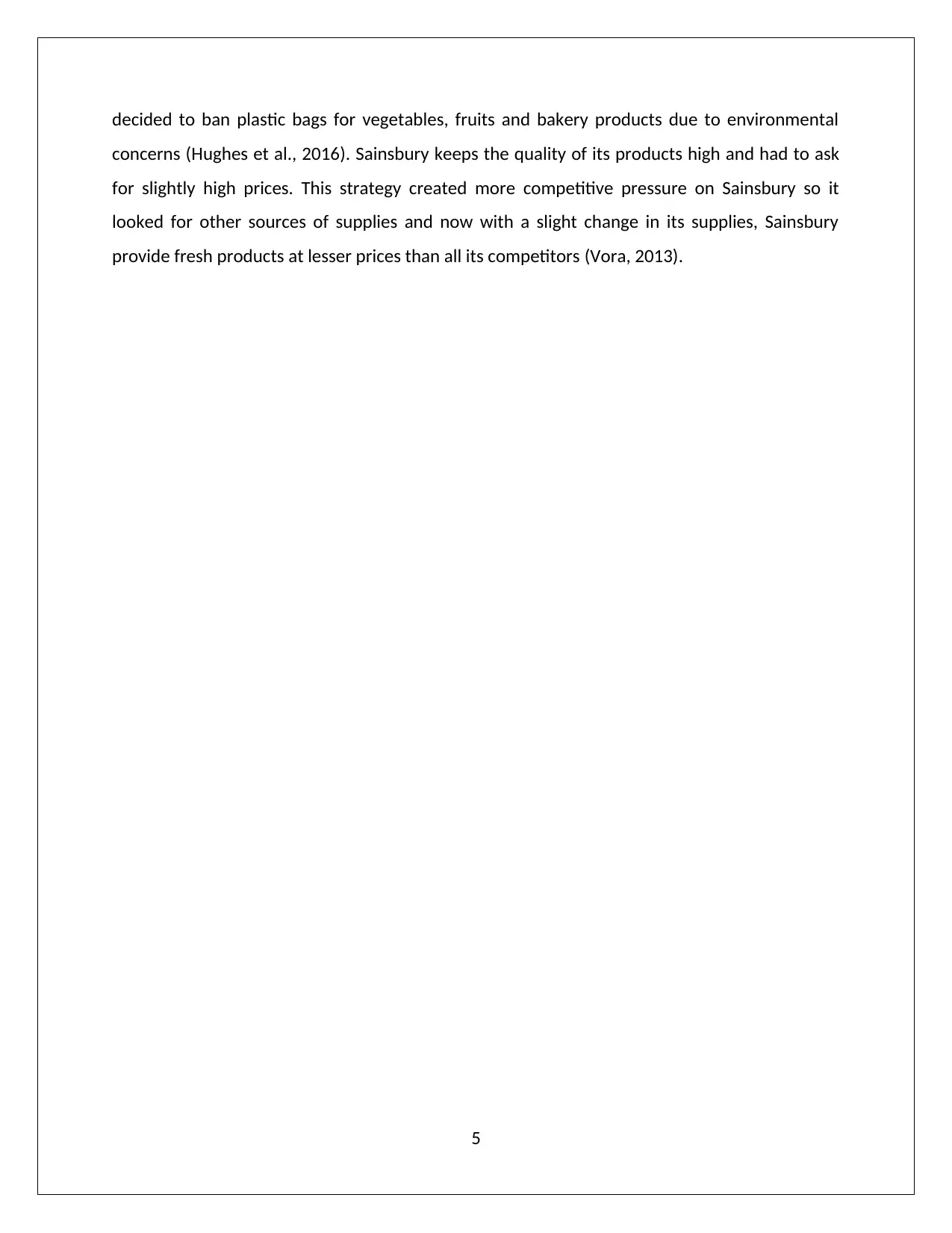
decided to ban plastic bags for vegetables, fruits and bakery products due to environmental
concerns (Hughes et al., 2016). Sainsbury keeps the quality of its products high and had to ask
for slightly high prices. This strategy created more competitive pressure on Sainsbury so it
looked for other sources of supplies and now with a slight change in its supplies, Sainsbury
provide fresh products at lesser prices than all its competitors (Vora, 2013).
5
concerns (Hughes et al., 2016). Sainsbury keeps the quality of its products high and had to ask
for slightly high prices. This strategy created more competitive pressure on Sainsbury so it
looked for other sources of supplies and now with a slight change in its supplies, Sainsbury
provide fresh products at lesser prices than all its competitors (Vora, 2013).
5
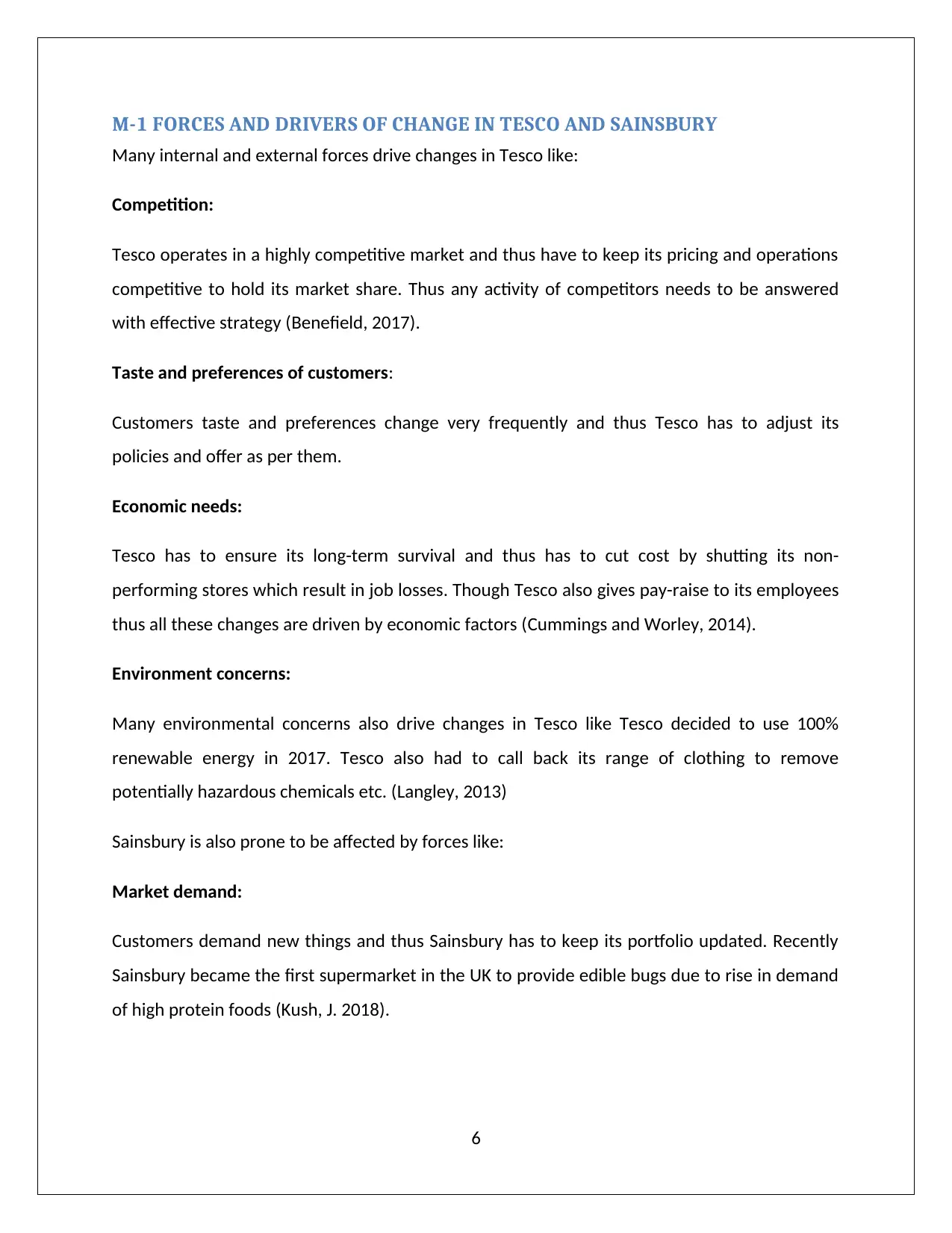
M-1 FORCES AND DRIVERS OF CHANGE IN TESCO AND SAINSBURY
Many internal and external forces drive changes in Tesco like:
Competition:
Tesco operates in a highly competitive market and thus have to keep its pricing and operations
competitive to hold its market share. Thus any activity of competitors needs to be answered
with effective strategy (Benefield, 2017).
Taste and preferences of customers:
Customers taste and preferences change very frequently and thus Tesco has to adjust its
policies and offer as per them.
Economic needs:
Tesco has to ensure its long-term survival and thus has to cut cost by shutting its non-
performing stores which result in job losses. Though Tesco also gives pay-raise to its employees
thus all these changes are driven by economic factors (Cummings and Worley, 2014).
Environment concerns:
Many environmental concerns also drive changes in Tesco like Tesco decided to use 100%
renewable energy in 2017. Tesco also had to call back its range of clothing to remove
potentially hazardous chemicals etc. (Langley, 2013)
Sainsbury is also prone to be affected by forces like:
Market demand:
Customers demand new things and thus Sainsbury has to keep its portfolio updated. Recently
Sainsbury became the first supermarket in the UK to provide edible bugs due to rise in demand
of high protein foods (Kush, J. 2018).
6
Many internal and external forces drive changes in Tesco like:
Competition:
Tesco operates in a highly competitive market and thus have to keep its pricing and operations
competitive to hold its market share. Thus any activity of competitors needs to be answered
with effective strategy (Benefield, 2017).
Taste and preferences of customers:
Customers taste and preferences change very frequently and thus Tesco has to adjust its
policies and offer as per them.
Economic needs:
Tesco has to ensure its long-term survival and thus has to cut cost by shutting its non-
performing stores which result in job losses. Though Tesco also gives pay-raise to its employees
thus all these changes are driven by economic factors (Cummings and Worley, 2014).
Environment concerns:
Many environmental concerns also drive changes in Tesco like Tesco decided to use 100%
renewable energy in 2017. Tesco also had to call back its range of clothing to remove
potentially hazardous chemicals etc. (Langley, 2013)
Sainsbury is also prone to be affected by forces like:
Market demand:
Customers demand new things and thus Sainsbury has to keep its portfolio updated. Recently
Sainsbury became the first supermarket in the UK to provide edible bugs due to rise in demand
of high protein foods (Kush, J. 2018).
6
Paraphrase This Document
Need a fresh take? Get an instant paraphrase of this document with our AI Paraphraser
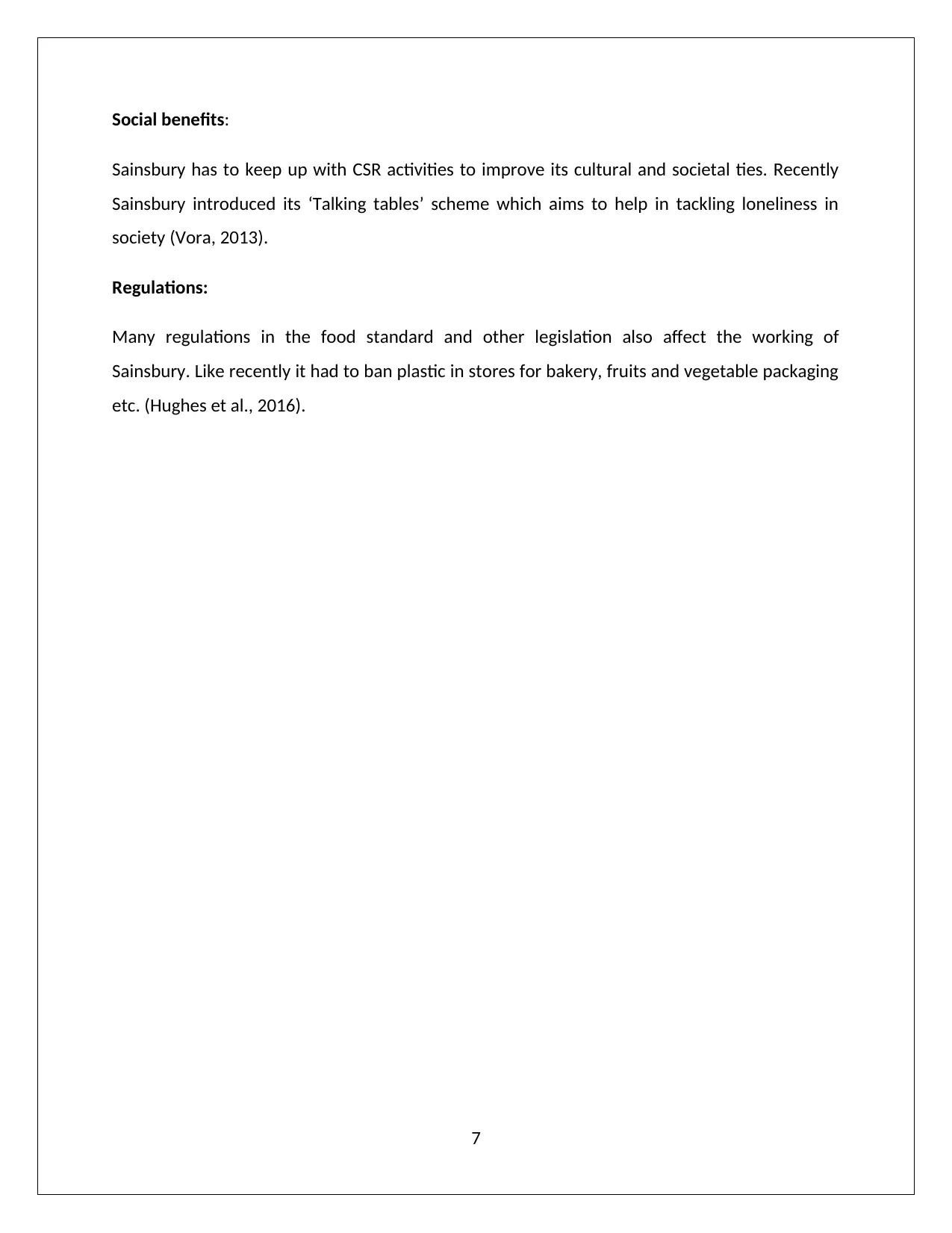
Social benefits:
Sainsbury has to keep up with CSR activities to improve its cultural and societal ties. Recently
Sainsbury introduced its ‘Talking tables’ scheme which aims to help in tackling loneliness in
society (Vora, 2013).
Regulations:
Many regulations in the food standard and other legislation also affect the working of
Sainsbury. Like recently it had to ban plastic in stores for bakery, fruits and vegetable packaging
etc. (Hughes et al., 2016).
7
Sainsbury has to keep up with CSR activities to improve its cultural and societal ties. Recently
Sainsbury introduced its ‘Talking tables’ scheme which aims to help in tackling loneliness in
society (Vora, 2013).
Regulations:
Many regulations in the food standard and other legislation also affect the working of
Sainsbury. Like recently it had to ban plastic in stores for bakery, fruits and vegetable packaging
etc. (Hughes et al., 2016).
7

LO-2
P-2 ANALYSIS AND EFFECTS OF DRIVERS OF CHANGE ON TESCO AND
SAINSBURY
TESCO
SWOT Analysis
STRENGTHS Strong portfolio of a variety of
products.
Strong presence and brand name in
the market.
Low priced products availability.
Good supplier's relationship to help in
providing low-cost goods while making
a profit (Kush, J. 2018).
High market share.
WEAKNESSES Image of a cheap quality provider
before some customers.
Past cases of malpractices like a
misrepresentation of profit etc.
Too much variety confuses the
customers.
OPPORTUNITIES Huge potential in the online market.
Expansion opportunities in developing
countries (Langley, 2013).
Increasing preference of customers to
premium quality products.
THREATS Current competition continuously
attracting Tesco’s market share.
Increasing global economic and
8
P-2 ANALYSIS AND EFFECTS OF DRIVERS OF CHANGE ON TESCO AND
SAINSBURY
TESCO
SWOT Analysis
STRENGTHS Strong portfolio of a variety of
products.
Strong presence and brand name in
the market.
Low priced products availability.
Good supplier's relationship to help in
providing low-cost goods while making
a profit (Kush, J. 2018).
High market share.
WEAKNESSES Image of a cheap quality provider
before some customers.
Past cases of malpractices like a
misrepresentation of profit etc.
Too much variety confuses the
customers.
OPPORTUNITIES Huge potential in the online market.
Expansion opportunities in developing
countries (Langley, 2013).
Increasing preference of customers to
premium quality products.
THREATS Current competition continuously
attracting Tesco’s market share.
Increasing global economic and
8
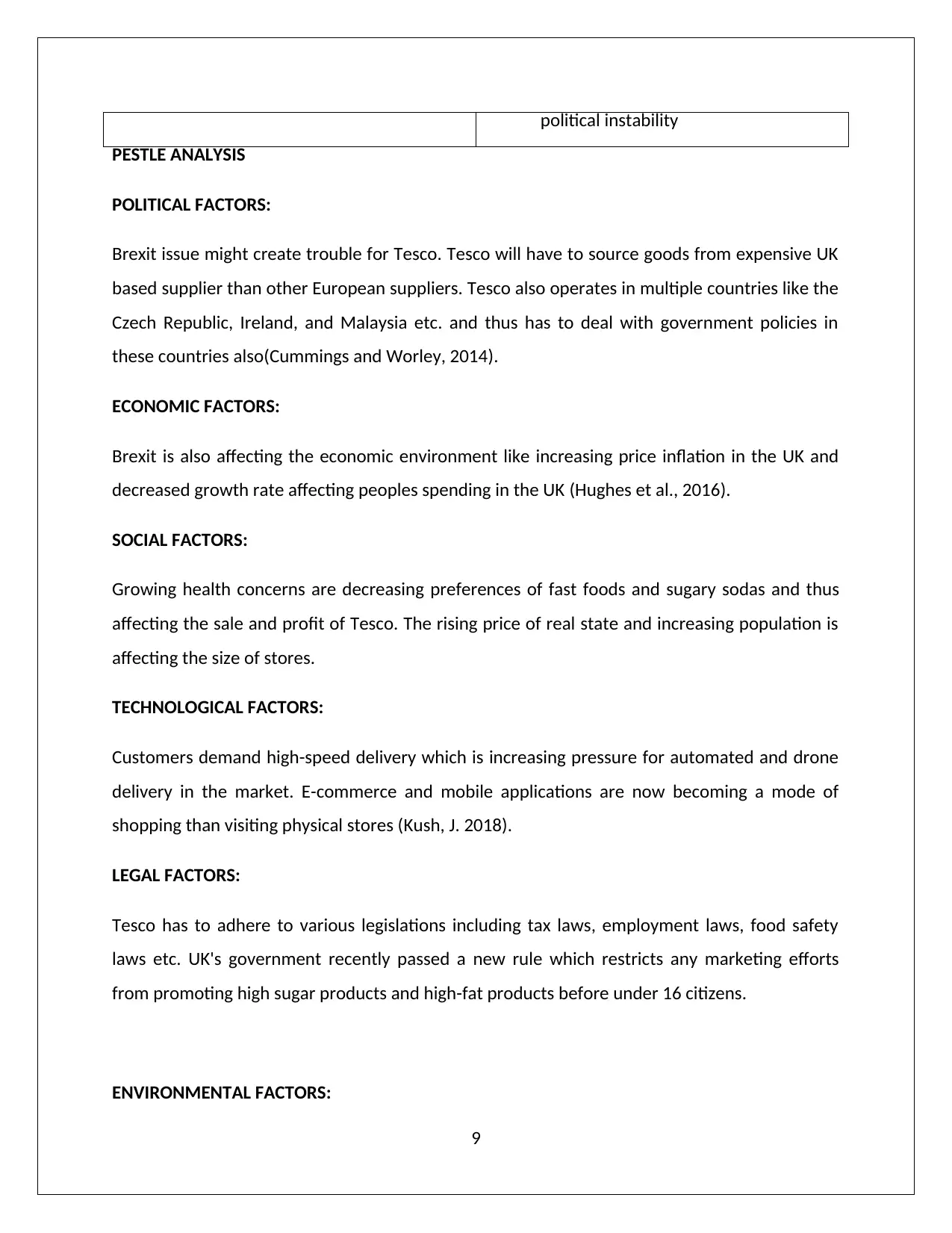
political instability
PESTLE ANALYSIS
POLITICAL FACTORS:
Brexit issue might create trouble for Tesco. Tesco will have to source goods from expensive UK
based supplier than other European suppliers. Tesco also operates in multiple countries like the
Czech Republic, Ireland, and Malaysia etc. and thus has to deal with government policies in
these countries also(Cummings and Worley, 2014).
ECONOMIC FACTORS:
Brexit is also affecting the economic environment like increasing price inflation in the UK and
decreased growth rate affecting peoples spending in the UK (Hughes et al., 2016).
SOCIAL FACTORS:
Growing health concerns are decreasing preferences of fast foods and sugary sodas and thus
affecting the sale and profit of Tesco. The rising price of real state and increasing population is
affecting the size of stores.
TECHNOLOGICAL FACTORS:
Customers demand high-speed delivery which is increasing pressure for automated and drone
delivery in the market. E-commerce and mobile applications are now becoming a mode of
shopping than visiting physical stores (Kush, J. 2018).
LEGAL FACTORS:
Tesco has to adhere to various legislations including tax laws, employment laws, food safety
laws etc. UK's government recently passed a new rule which restricts any marketing efforts
from promoting high sugar products and high-fat products before under 16 citizens.
ENVIRONMENTAL FACTORS:
9
PESTLE ANALYSIS
POLITICAL FACTORS:
Brexit issue might create trouble for Tesco. Tesco will have to source goods from expensive UK
based supplier than other European suppliers. Tesco also operates in multiple countries like the
Czech Republic, Ireland, and Malaysia etc. and thus has to deal with government policies in
these countries also(Cummings and Worley, 2014).
ECONOMIC FACTORS:
Brexit is also affecting the economic environment like increasing price inflation in the UK and
decreased growth rate affecting peoples spending in the UK (Hughes et al., 2016).
SOCIAL FACTORS:
Growing health concerns are decreasing preferences of fast foods and sugary sodas and thus
affecting the sale and profit of Tesco. The rising price of real state and increasing population is
affecting the size of stores.
TECHNOLOGICAL FACTORS:
Customers demand high-speed delivery which is increasing pressure for automated and drone
delivery in the market. E-commerce and mobile applications are now becoming a mode of
shopping than visiting physical stores (Kush, J. 2018).
LEGAL FACTORS:
Tesco has to adhere to various legislations including tax laws, employment laws, food safety
laws etc. UK's government recently passed a new rule which restricts any marketing efforts
from promoting high sugar products and high-fat products before under 16 citizens.
ENVIRONMENTAL FACTORS:
9
Secure Best Marks with AI Grader
Need help grading? Try our AI Grader for instant feedback on your assignments.

Tesco has decided to use 100% renewable energy and ban plastic bags in its stores due to rising
environmental concerns (Hornstein, 2015).
SAINSBURY
SWOT Analysis
STRENGTHS Strong Online presence.
A good image for providing quality
products.
Competitive advantage gained in the
non-food market by acquiring Argos.
Strong network and a large number of
stores.
Own label.
WEAKNESSES Limited to only UK’s market.
Losses of Argos are major concerns and
affecting Sainsbury’s profit.
OPPORTUNITIES Potential of Global expansion.
Gain market share by improving the
portfolio.
THREATS Decreasing the trust of customers.
Poor economic performance of the UK
after Brexit.
PESTLE ANALYSIS
10
environmental concerns (Hornstein, 2015).
SAINSBURY
SWOT Analysis
STRENGTHS Strong Online presence.
A good image for providing quality
products.
Competitive advantage gained in the
non-food market by acquiring Argos.
Strong network and a large number of
stores.
Own label.
WEAKNESSES Limited to only UK’s market.
Losses of Argos are major concerns and
affecting Sainsbury’s profit.
OPPORTUNITIES Potential of Global expansion.
Gain market share by improving the
portfolio.
THREATS Decreasing the trust of customers.
Poor economic performance of the UK
after Brexit.
PESTLE ANALYSIS
10
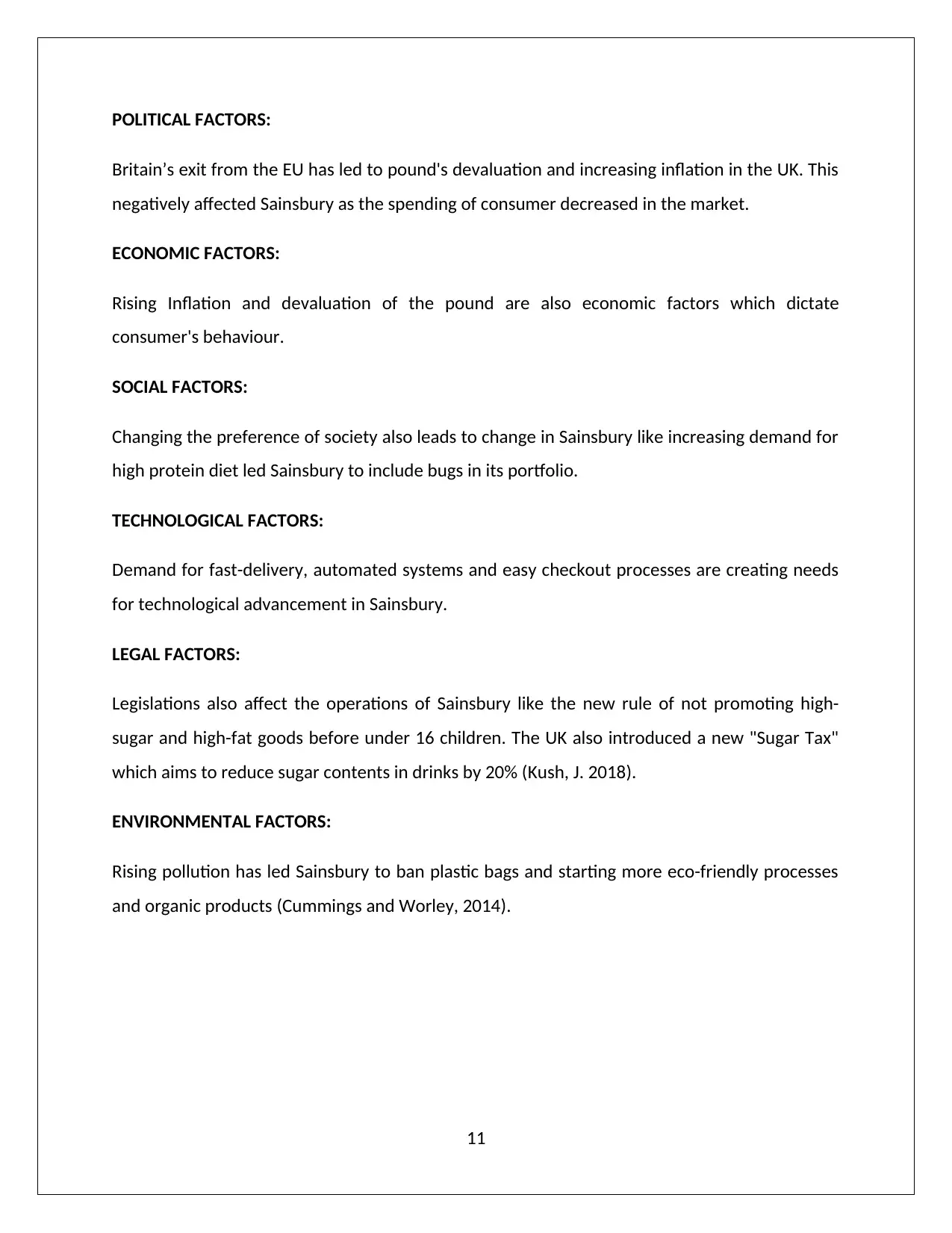
POLITICAL FACTORS:
Britain’s exit from the EU has led to pound's devaluation and increasing inflation in the UK. This
negatively affected Sainsbury as the spending of consumer decreased in the market.
ECONOMIC FACTORS:
Rising Inflation and devaluation of the pound are also economic factors which dictate
consumer's behaviour.
SOCIAL FACTORS:
Changing the preference of society also leads to change in Sainsbury like increasing demand for
high protein diet led Sainsbury to include bugs in its portfolio.
TECHNOLOGICAL FACTORS:
Demand for fast-delivery, automated systems and easy checkout processes are creating needs
for technological advancement in Sainsbury.
LEGAL FACTORS:
Legislations also affect the operations of Sainsbury like the new rule of not promoting high-
sugar and high-fat goods before under 16 children. The UK also introduced a new "Sugar Tax"
which aims to reduce sugar contents in drinks by 20% (Kush, J. 2018).
ENVIRONMENTAL FACTORS:
Rising pollution has led Sainsbury to ban plastic bags and starting more eco-friendly processes
and organic products (Cummings and Worley, 2014).
11
Britain’s exit from the EU has led to pound's devaluation and increasing inflation in the UK. This
negatively affected Sainsbury as the spending of consumer decreased in the market.
ECONOMIC FACTORS:
Rising Inflation and devaluation of the pound are also economic factors which dictate
consumer's behaviour.
SOCIAL FACTORS:
Changing the preference of society also leads to change in Sainsbury like increasing demand for
high protein diet led Sainsbury to include bugs in its portfolio.
TECHNOLOGICAL FACTORS:
Demand for fast-delivery, automated systems and easy checkout processes are creating needs
for technological advancement in Sainsbury.
LEGAL FACTORS:
Legislations also affect the operations of Sainsbury like the new rule of not promoting high-
sugar and high-fat goods before under 16 children. The UK also introduced a new "Sugar Tax"
which aims to reduce sugar contents in drinks by 20% (Kush, J. 2018).
ENVIRONMENTAL FACTORS:
Rising pollution has led Sainsbury to ban plastic bags and starting more eco-friendly processes
and organic products (Cummings and Worley, 2014).
11

P-3 MODELS TO REDUCE NEGATIVE IMPACT AND SERVE CHANGE
There are many negative impacts of change like decrease in the motivation of employees, rising
stress on the employees, challenge to authority, a confusing chain of command, unclear job
roles and duties, dropping or overlapping of important task etc. (Vora, 2013). All these changes
can be dealt with the following models:
BURKE LITWIN CHANGE MODEL
Figure 1: BURKE LITWIN CHANGE MODEL
(Source: Hussain et al, 2018)
This model observes twelve key dimensions of change and defines and establishes a
relationship between them (Thakur, 2019). The dimensions are as follows:
12
There are many negative impacts of change like decrease in the motivation of employees, rising
stress on the employees, challenge to authority, a confusing chain of command, unclear job
roles and duties, dropping or overlapping of important task etc. (Vora, 2013). All these changes
can be dealt with the following models:
BURKE LITWIN CHANGE MODEL
Figure 1: BURKE LITWIN CHANGE MODEL
(Source: Hussain et al, 2018)
This model observes twelve key dimensions of change and defines and establishes a
relationship between them (Thakur, 2019). The dimensions are as follows:
12
Paraphrase This Document
Need a fresh take? Get an instant paraphrase of this document with our AI Paraphraser
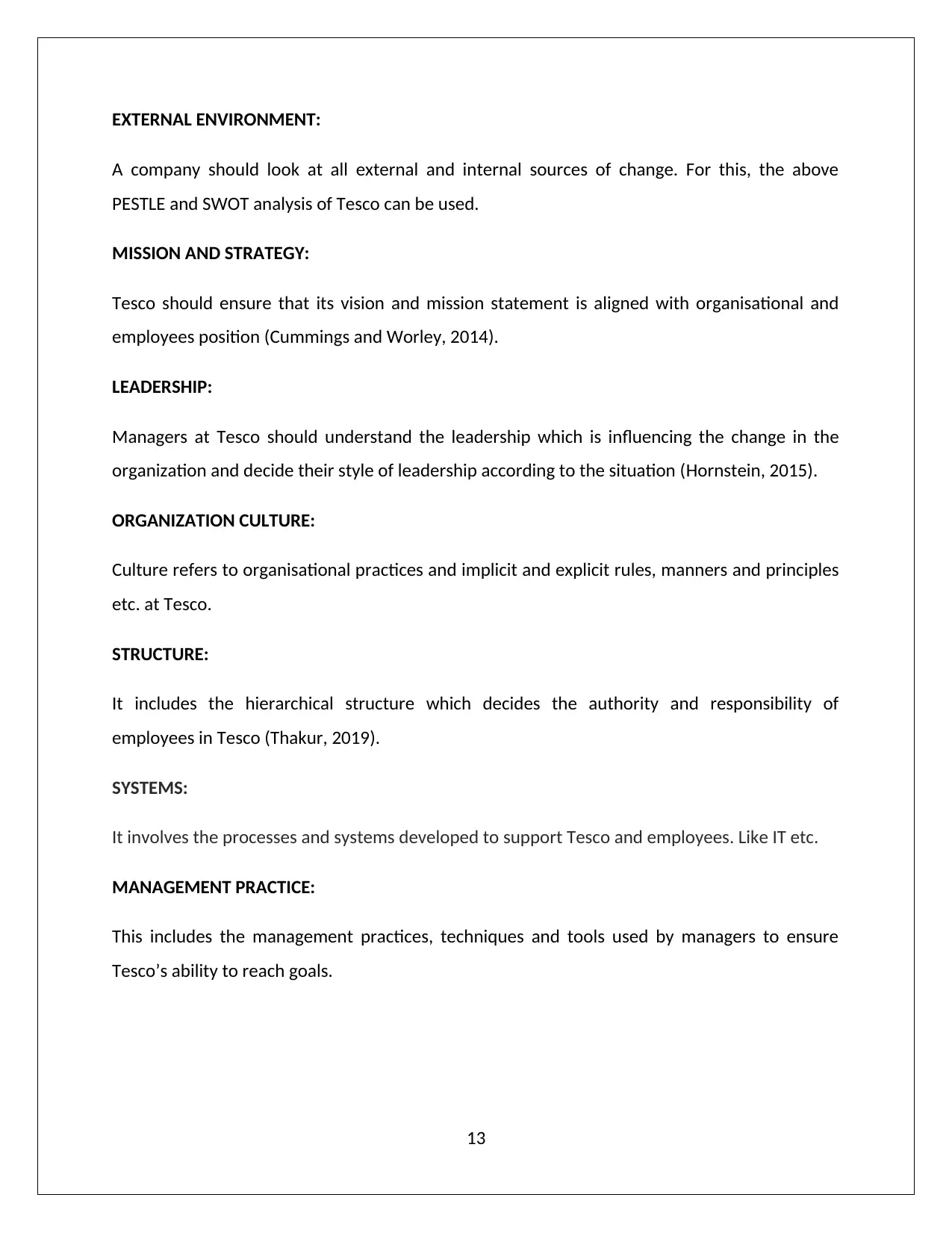
EXTERNAL ENVIRONMENT:
A company should look at all external and internal sources of change. For this, the above
PESTLE and SWOT analysis of Tesco can be used.
MISSION AND STRATEGY:
Tesco should ensure that its vision and mission statement is aligned with organisational and
employees position (Cummings and Worley, 2014).
LEADERSHIP:
Managers at Tesco should understand the leadership which is influencing the change in the
organization and decide their style of leadership according to the situation (Hornstein, 2015).
ORGANIZATION CULTURE:
Culture refers to organisational practices and implicit and explicit rules, manners and principles
etc. at Tesco.
STRUCTURE:
It includes the hierarchical structure which decides the authority and responsibility of
employees in Tesco (Thakur, 2019).
SYSTEMS:
It involves the processes and systems developed to support Tesco and employees. Like IT etc.
MANAGEMENT PRACTICE:
This includes the management practices, techniques and tools used by managers to ensure
Tesco’s ability to reach goals.
13
A company should look at all external and internal sources of change. For this, the above
PESTLE and SWOT analysis of Tesco can be used.
MISSION AND STRATEGY:
Tesco should ensure that its vision and mission statement is aligned with organisational and
employees position (Cummings and Worley, 2014).
LEADERSHIP:
Managers at Tesco should understand the leadership which is influencing the change in the
organization and decide their style of leadership according to the situation (Hornstein, 2015).
ORGANIZATION CULTURE:
Culture refers to organisational practices and implicit and explicit rules, manners and principles
etc. at Tesco.
STRUCTURE:
It includes the hierarchical structure which decides the authority and responsibility of
employees in Tesco (Thakur, 2019).
SYSTEMS:
It involves the processes and systems developed to support Tesco and employees. Like IT etc.
MANAGEMENT PRACTICE:
This includes the management practices, techniques and tools used by managers to ensure
Tesco’s ability to reach goals.
13
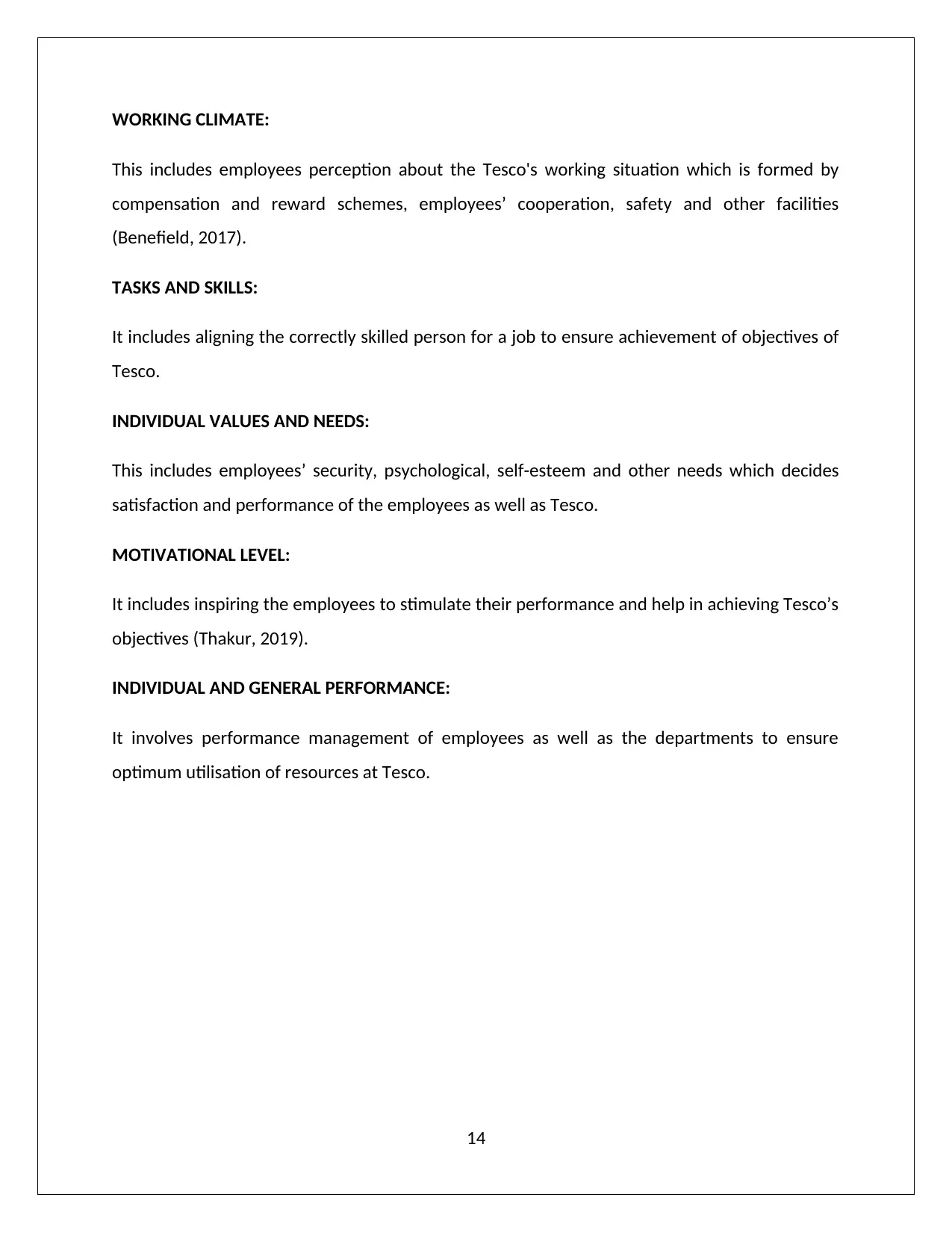
WORKING CLIMATE:
This includes employees perception about the Tesco's working situation which is formed by
compensation and reward schemes, employees’ cooperation, safety and other facilities
(Benefield, 2017).
TASKS AND SKILLS:
It includes aligning the correctly skilled person for a job to ensure achievement of objectives of
Tesco.
INDIVIDUAL VALUES AND NEEDS:
This includes employees’ security, psychological, self-esteem and other needs which decides
satisfaction and performance of the employees as well as Tesco.
MOTIVATIONAL LEVEL:
It includes inspiring the employees to stimulate their performance and help in achieving Tesco’s
objectives (Thakur, 2019).
INDIVIDUAL AND GENERAL PERFORMANCE:
It involves performance management of employees as well as the departments to ensure
optimum utilisation of resources at Tesco.
14
This includes employees perception about the Tesco's working situation which is formed by
compensation and reward schemes, employees’ cooperation, safety and other facilities
(Benefield, 2017).
TASKS AND SKILLS:
It includes aligning the correctly skilled person for a job to ensure achievement of objectives of
Tesco.
INDIVIDUAL VALUES AND NEEDS:
This includes employees’ security, psychological, self-esteem and other needs which decides
satisfaction and performance of the employees as well as Tesco.
MOTIVATIONAL LEVEL:
It includes inspiring the employees to stimulate their performance and help in achieving Tesco’s
objectives (Thakur, 2019).
INDIVIDUAL AND GENERAL PERFORMANCE:
It involves performance management of employees as well as the departments to ensure
optimum utilisation of resources at Tesco.
14
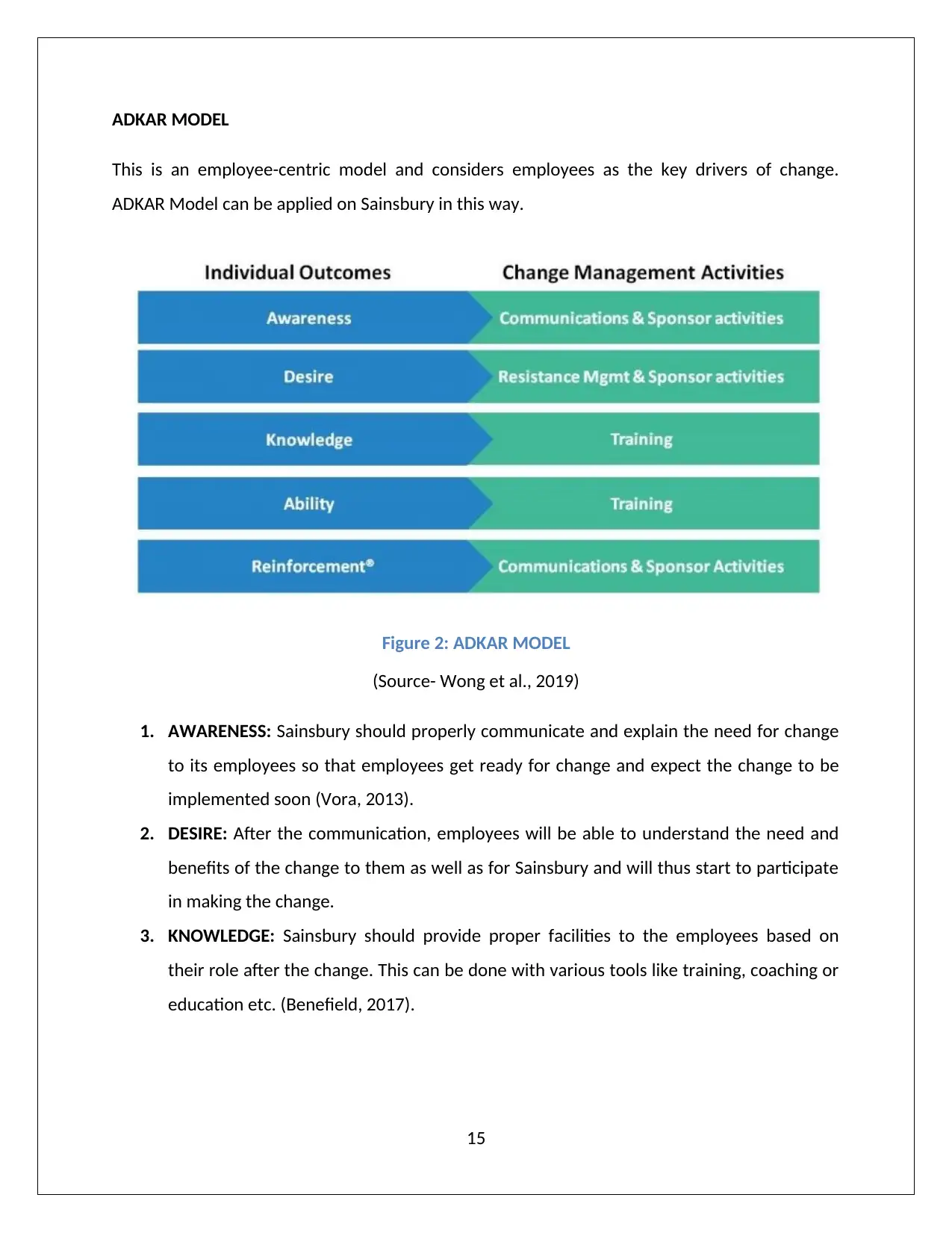
ADKAR MODEL
This is an employee-centric model and considers employees as the key drivers of change.
ADKAR Model can be applied on Sainsbury in this way.
Figure 2: ADKAR MODEL
(Source- Wong et al., 2019)
1. AWARENESS: Sainsbury should properly communicate and explain the need for change
to its employees so that employees get ready for change and expect the change to be
implemented soon (Vora, 2013).
2. DESIRE: After the communication, employees will be able to understand the need and
benefits of the change to them as well as for Sainsbury and will thus start to participate
in making the change.
3. KNOWLEDGE: Sainsbury should provide proper facilities to the employees based on
their role after the change. This can be done with various tools like training, coaching or
education etc. (Benefield, 2017).
15
This is an employee-centric model and considers employees as the key drivers of change.
ADKAR Model can be applied on Sainsbury in this way.
Figure 2: ADKAR MODEL
(Source- Wong et al., 2019)
1. AWARENESS: Sainsbury should properly communicate and explain the need for change
to its employees so that employees get ready for change and expect the change to be
implemented soon (Vora, 2013).
2. DESIRE: After the communication, employees will be able to understand the need and
benefits of the change to them as well as for Sainsbury and will thus start to participate
in making the change.
3. KNOWLEDGE: Sainsbury should provide proper facilities to the employees based on
their role after the change. This can be done with various tools like training, coaching or
education etc. (Benefield, 2017).
15
Secure Best Marks with AI Grader
Need help grading? Try our AI Grader for instant feedback on your assignments.
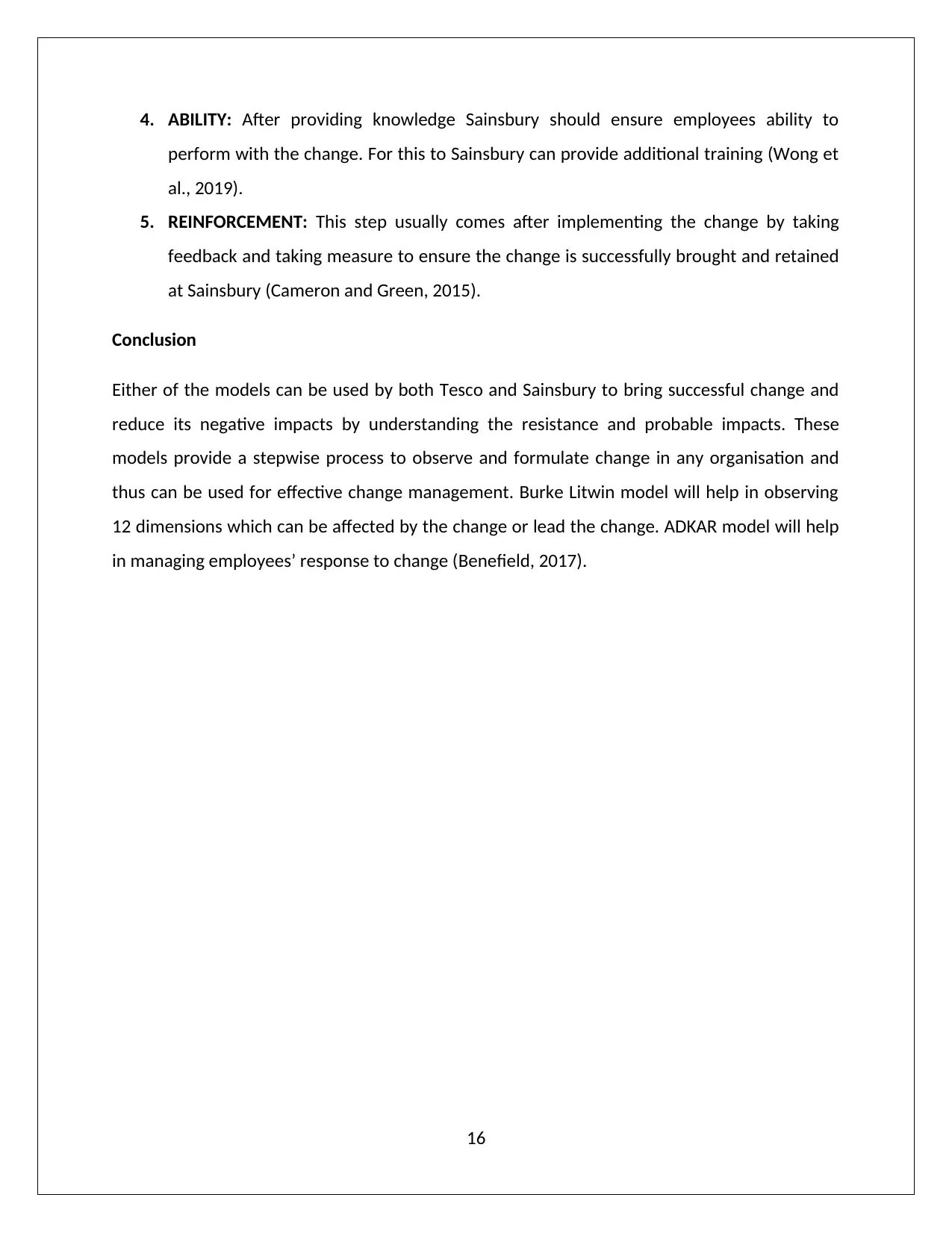
4. ABILITY: After providing knowledge Sainsbury should ensure employees ability to
perform with the change. For this to Sainsbury can provide additional training (Wong et
al., 2019).
5. REINFORCEMENT: This step usually comes after implementing the change by taking
feedback and taking measure to ensure the change is successfully brought and retained
at Sainsbury (Cameron and Green, 2015).
Conclusion
Either of the models can be used by both Tesco and Sainsbury to bring successful change and
reduce its negative impacts by understanding the resistance and probable impacts. These
models provide a stepwise process to observe and formulate change in any organisation and
thus can be used for effective change management. Burke Litwin model will help in observing
12 dimensions which can be affected by the change or lead the change. ADKAR model will help
in managing employees’ response to change (Benefield, 2017).
16
perform with the change. For this to Sainsbury can provide additional training (Wong et
al., 2019).
5. REINFORCEMENT: This step usually comes after implementing the change by taking
feedback and taking measure to ensure the change is successfully brought and retained
at Sainsbury (Cameron and Green, 2015).
Conclusion
Either of the models can be used by both Tesco and Sainsbury to bring successful change and
reduce its negative impacts by understanding the resistance and probable impacts. These
models provide a stepwise process to observe and formulate change in any organisation and
thus can be used for effective change management. Burke Litwin model will help in observing
12 dimensions which can be affected by the change or lead the change. ADKAR model will help
in managing employees’ response to change (Benefield, 2017).
16
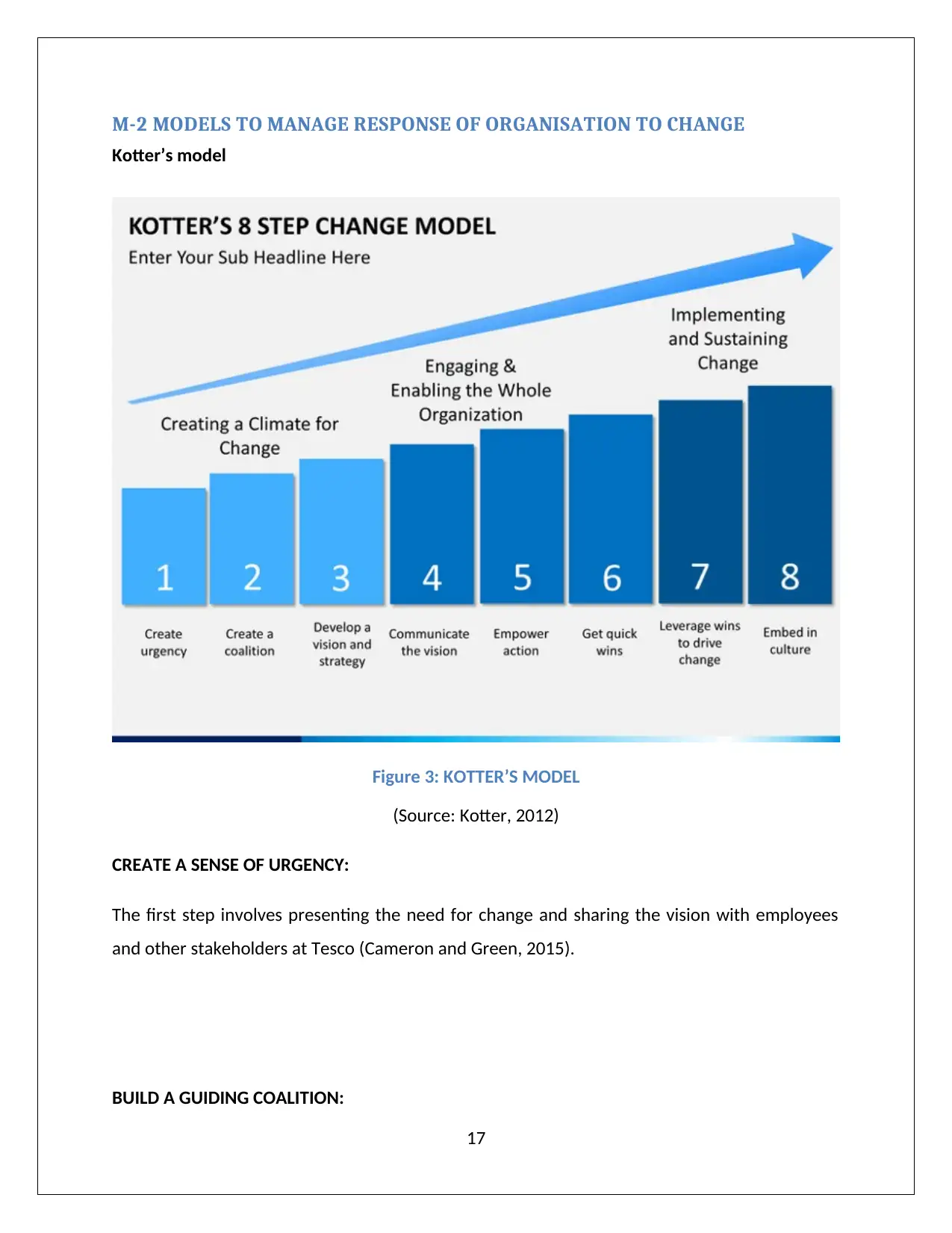
M-2 MODELS TO MANAGE RESPONSE OF ORGANISATION TO CHANGE
Kotter’s model
Figure 3: KOTTER’S MODEL
(Source: Kotter, 2012)
CREATE A SENSE OF URGENCY:
The first step involves presenting the need for change and sharing the vision with employees
and other stakeholders at Tesco (Cameron and Green, 2015).
BUILD A GUIDING COALITION:
17
Kotter’s model
Figure 3: KOTTER’S MODEL
(Source: Kotter, 2012)
CREATE A SENSE OF URGENCY:
The first step involves presenting the need for change and sharing the vision with employees
and other stakeholders at Tesco (Cameron and Green, 2015).
BUILD A GUIDING COALITION:
17

In second step management of Tesco should appoint a team to suggest the trajectory of change
by analyzing all the dimensions of effect and then leading the change in the organization
(Cummings and Worley, 2014).
FORM A STRATEGIC VISION AND INITIATIVES:
This step involves creating a solid plan for change and its movement to help everyone in
aligning with the process of change at Tesco (Benn et al., 2014).
ENLIST A VOLUNTEER ARMY:
In the fourth step employees of Tesco should be invited to be a part of the change voluntarily
and contribute towards the change process (Hornstein, 2015).
ENABLE ACTION BY REMOVING BARRIERS:
The fifth step involves eliminating the barriers or hurdles in the change-making process at Tesco
by combined efforts. The barriers could be employees’ resistance, individual issues, inflexible
processes etc. (Vora, 2013).
GENERATE SHORT-TERM WINS:
Here short term objectives of the change plans should be achieved to ensure the progress of
change at Tesco (Kotter, 2012).
SUSTAIN ACCELERATION:
By this step, Tesco should enhance its efforts to the change process and aim to attain change as
soon as possible.
INSTITUTE CHANGE:
In the last step Tesco should ensure the retainment of change in the organization to ensure that
the whole process delivers stable results.
18
by analyzing all the dimensions of effect and then leading the change in the organization
(Cummings and Worley, 2014).
FORM A STRATEGIC VISION AND INITIATIVES:
This step involves creating a solid plan for change and its movement to help everyone in
aligning with the process of change at Tesco (Benn et al., 2014).
ENLIST A VOLUNTEER ARMY:
In the fourth step employees of Tesco should be invited to be a part of the change voluntarily
and contribute towards the change process (Hornstein, 2015).
ENABLE ACTION BY REMOVING BARRIERS:
The fifth step involves eliminating the barriers or hurdles in the change-making process at Tesco
by combined efforts. The barriers could be employees’ resistance, individual issues, inflexible
processes etc. (Vora, 2013).
GENERATE SHORT-TERM WINS:
Here short term objectives of the change plans should be achieved to ensure the progress of
change at Tesco (Kotter, 2012).
SUSTAIN ACCELERATION:
By this step, Tesco should enhance its efforts to the change process and aim to attain change as
soon as possible.
INSTITUTE CHANGE:
In the last step Tesco should ensure the retainment of change in the organization to ensure that
the whole process delivers stable results.
18
Paraphrase This Document
Need a fresh take? Get an instant paraphrase of this document with our AI Paraphraser
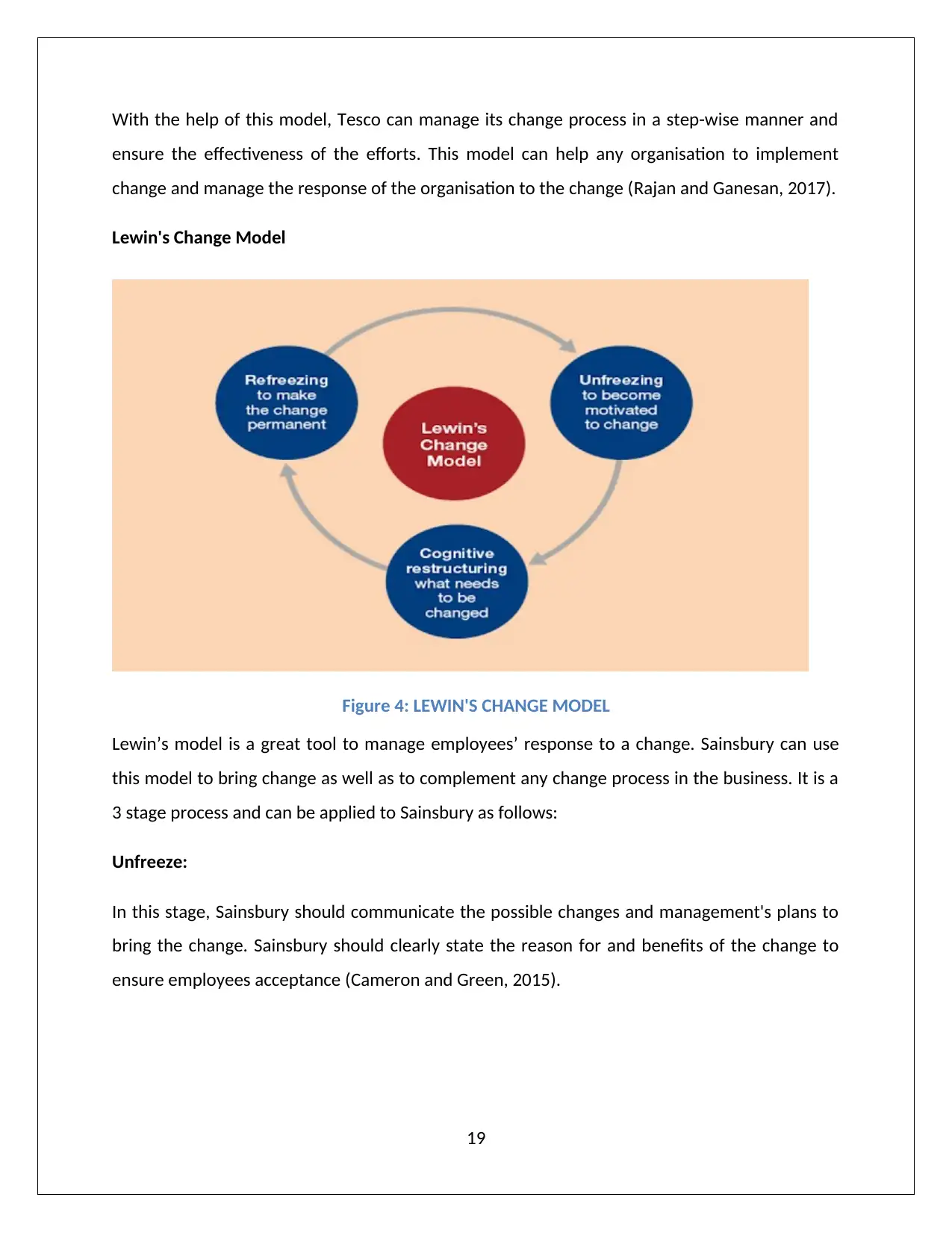
With the help of this model, Tesco can manage its change process in a step-wise manner and
ensure the effectiveness of the efforts. This model can help any organisation to implement
change and manage the response of the organisation to the change (Rajan and Ganesan, 2017).
Lewin's Change Model
Figure 4: LEWIN'S CHANGE MODEL
Lewin’s model is a great tool to manage employees’ response to a change. Sainsbury can use
this model to bring change as well as to complement any change process in the business. It is a
3 stage process and can be applied to Sainsbury as follows:
Unfreeze:
In this stage, Sainsbury should communicate the possible changes and management's plans to
bring the change. Sainsbury should clearly state the reason for and benefits of the change to
ensure employees acceptance (Cameron and Green, 2015).
19
ensure the effectiveness of the efforts. This model can help any organisation to implement
change and manage the response of the organisation to the change (Rajan and Ganesan, 2017).
Lewin's Change Model
Figure 4: LEWIN'S CHANGE MODEL
Lewin’s model is a great tool to manage employees’ response to a change. Sainsbury can use
this model to bring change as well as to complement any change process in the business. It is a
3 stage process and can be applied to Sainsbury as follows:
Unfreeze:
In this stage, Sainsbury should communicate the possible changes and management's plans to
bring the change. Sainsbury should clearly state the reason for and benefits of the change to
ensure employees acceptance (Cameron and Green, 2015).
19
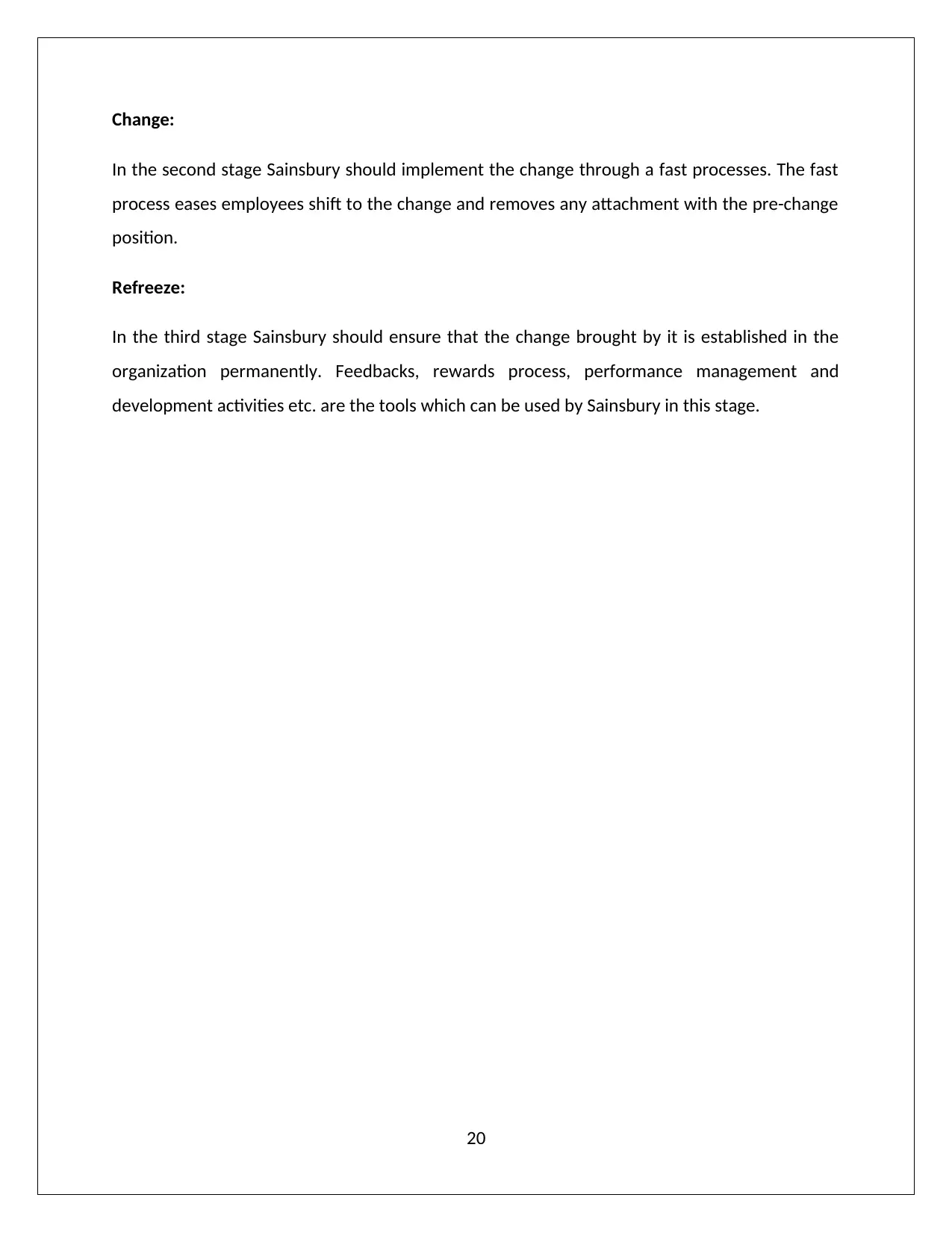
Change:
In the second stage Sainsbury should implement the change through a fast processes. The fast
process eases employees shift to the change and removes any attachment with the pre-change
position.
Refreeze:
In the third stage Sainsbury should ensure that the change brought by it is established in the
organization permanently. Feedbacks, rewards process, performance management and
development activities etc. are the tools which can be used by Sainsbury in this stage.
20
In the second stage Sainsbury should implement the change through a fast processes. The fast
process eases employees shift to the change and removes any attachment with the pre-change
position.
Refreeze:
In the third stage Sainsbury should ensure that the change brought by it is established in the
organization permanently. Feedbacks, rewards process, performance management and
development activities etc. are the tools which can be used by Sainsbury in this stage.
20
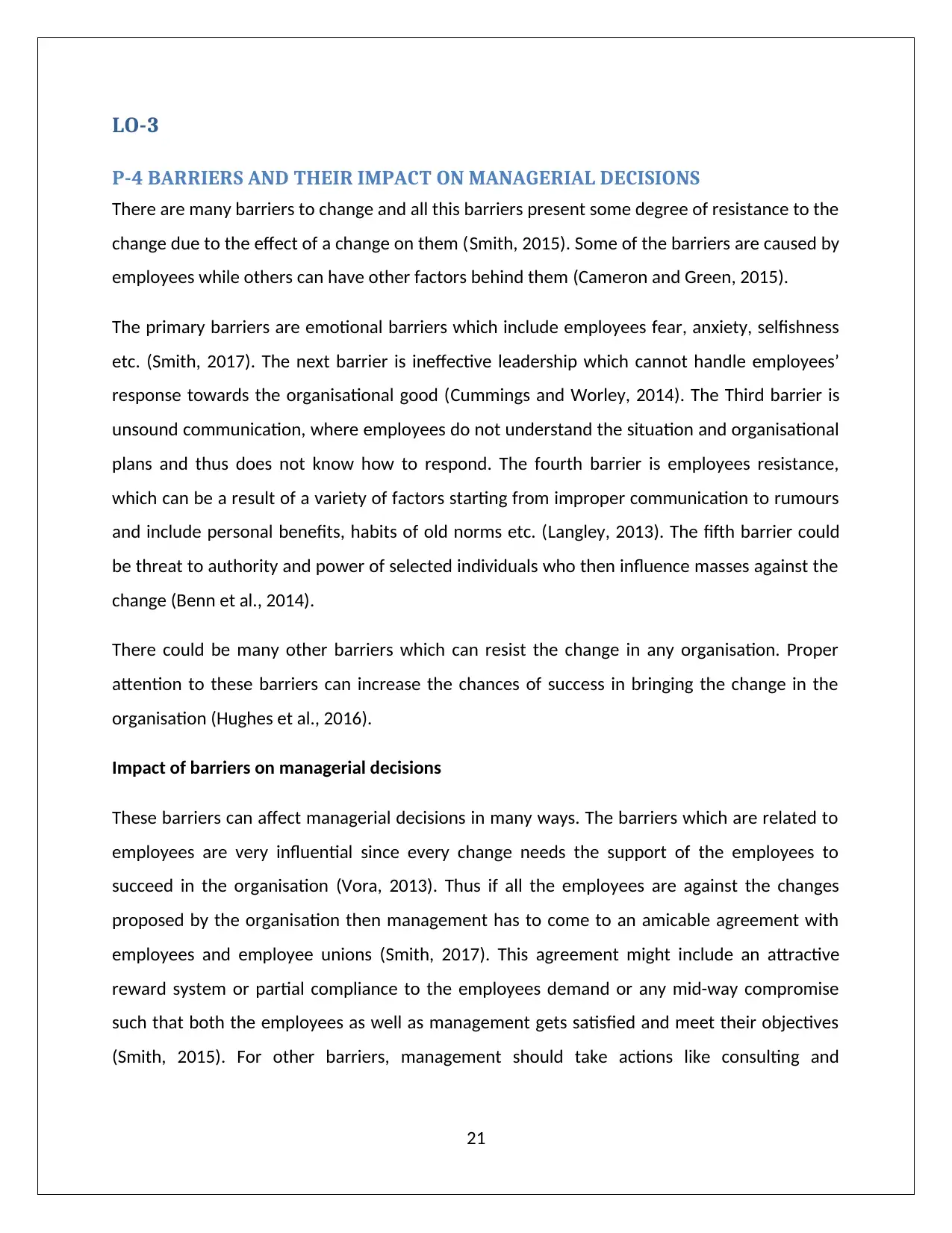
LO-3
P-4 BARRIERS AND THEIR IMPACT ON MANAGERIAL DECISIONS
There are many barriers to change and all this barriers present some degree of resistance to the
change due to the effect of a change on them (Smith, 2015). Some of the barriers are caused by
employees while others can have other factors behind them (Cameron and Green, 2015).
The primary barriers are emotional barriers which include employees fear, anxiety, selfishness
etc. (Smith, 2017). The next barrier is ineffective leadership which cannot handle employees’
response towards the organisational good (Cummings and Worley, 2014). The Third barrier is
unsound communication, where employees do not understand the situation and organisational
plans and thus does not know how to respond. The fourth barrier is employees resistance,
which can be a result of a variety of factors starting from improper communication to rumours
and include personal benefits, habits of old norms etc. (Langley, 2013). The fifth barrier could
be threat to authority and power of selected individuals who then influence masses against the
change (Benn et al., 2014).
There could be many other barriers which can resist the change in any organisation. Proper
attention to these barriers can increase the chances of success in bringing the change in the
organisation (Hughes et al., 2016).
Impact of barriers on managerial decisions
These barriers can affect managerial decisions in many ways. The barriers which are related to
employees are very influential since every change needs the support of the employees to
succeed in the organisation (Vora, 2013). Thus if all the employees are against the changes
proposed by the organisation then management has to come to an amicable agreement with
employees and employee unions (Smith, 2017). This agreement might include an attractive
reward system or partial compliance to the employees demand or any mid-way compromise
such that both the employees as well as management gets satisfied and meet their objectives
(Smith, 2015). For other barriers, management should take actions like consulting and
21
P-4 BARRIERS AND THEIR IMPACT ON MANAGERIAL DECISIONS
There are many barriers to change and all this barriers present some degree of resistance to the
change due to the effect of a change on them (Smith, 2015). Some of the barriers are caused by
employees while others can have other factors behind them (Cameron and Green, 2015).
The primary barriers are emotional barriers which include employees fear, anxiety, selfishness
etc. (Smith, 2017). The next barrier is ineffective leadership which cannot handle employees’
response towards the organisational good (Cummings and Worley, 2014). The Third barrier is
unsound communication, where employees do not understand the situation and organisational
plans and thus does not know how to respond. The fourth barrier is employees resistance,
which can be a result of a variety of factors starting from improper communication to rumours
and include personal benefits, habits of old norms etc. (Langley, 2013). The fifth barrier could
be threat to authority and power of selected individuals who then influence masses against the
change (Benn et al., 2014).
There could be many other barriers which can resist the change in any organisation. Proper
attention to these barriers can increase the chances of success in bringing the change in the
organisation (Hughes et al., 2016).
Impact of barriers on managerial decisions
These barriers can affect managerial decisions in many ways. The barriers which are related to
employees are very influential since every change needs the support of the employees to
succeed in the organisation (Vora, 2013). Thus if all the employees are against the changes
proposed by the organisation then management has to come to an amicable agreement with
employees and employee unions (Smith, 2017). This agreement might include an attractive
reward system or partial compliance to the employees demand or any mid-way compromise
such that both the employees as well as management gets satisfied and meet their objectives
(Smith, 2015). For other barriers, management should take actions like consulting and
21
Secure Best Marks with AI Grader
Need help grading? Try our AI Grader for instant feedback on your assignments.

communicating change with all the concerned sections of the organisation or changing the
responsible persons to get effective results.
22
responsible persons to get effective results.
22
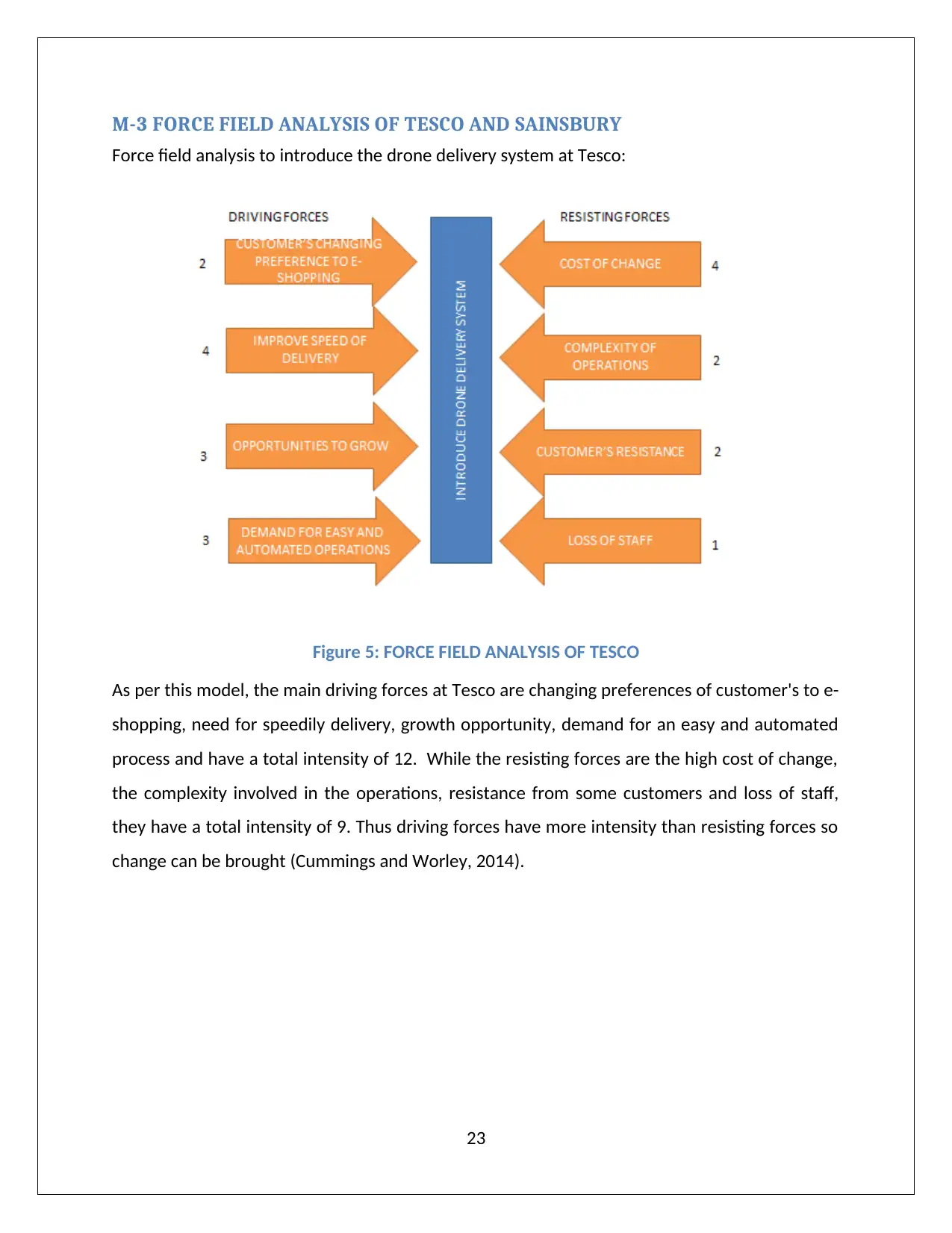
M-3 FORCE FIELD ANALYSIS OF TESCO AND SAINSBURY
Force field analysis to introduce the drone delivery system at Tesco:
Figure 5: FORCE FIELD ANALYSIS OF TESCO
As per this model, the main driving forces at Tesco are changing preferences of customer's to e-
shopping, need for speedily delivery, growth opportunity, demand for an easy and automated
process and have a total intensity of 12. While the resisting forces are the high cost of change,
the complexity involved in the operations, resistance from some customers and loss of staff,
they have a total intensity of 9. Thus driving forces have more intensity than resisting forces so
change can be brought (Cummings and Worley, 2014).
23
Force field analysis to introduce the drone delivery system at Tesco:
Figure 5: FORCE FIELD ANALYSIS OF TESCO
As per this model, the main driving forces at Tesco are changing preferences of customer's to e-
shopping, need for speedily delivery, growth opportunity, demand for an easy and automated
process and have a total intensity of 12. While the resisting forces are the high cost of change,
the complexity involved in the operations, resistance from some customers and loss of staff,
they have a total intensity of 9. Thus driving forces have more intensity than resisting forces so
change can be brought (Cummings and Worley, 2014).
23
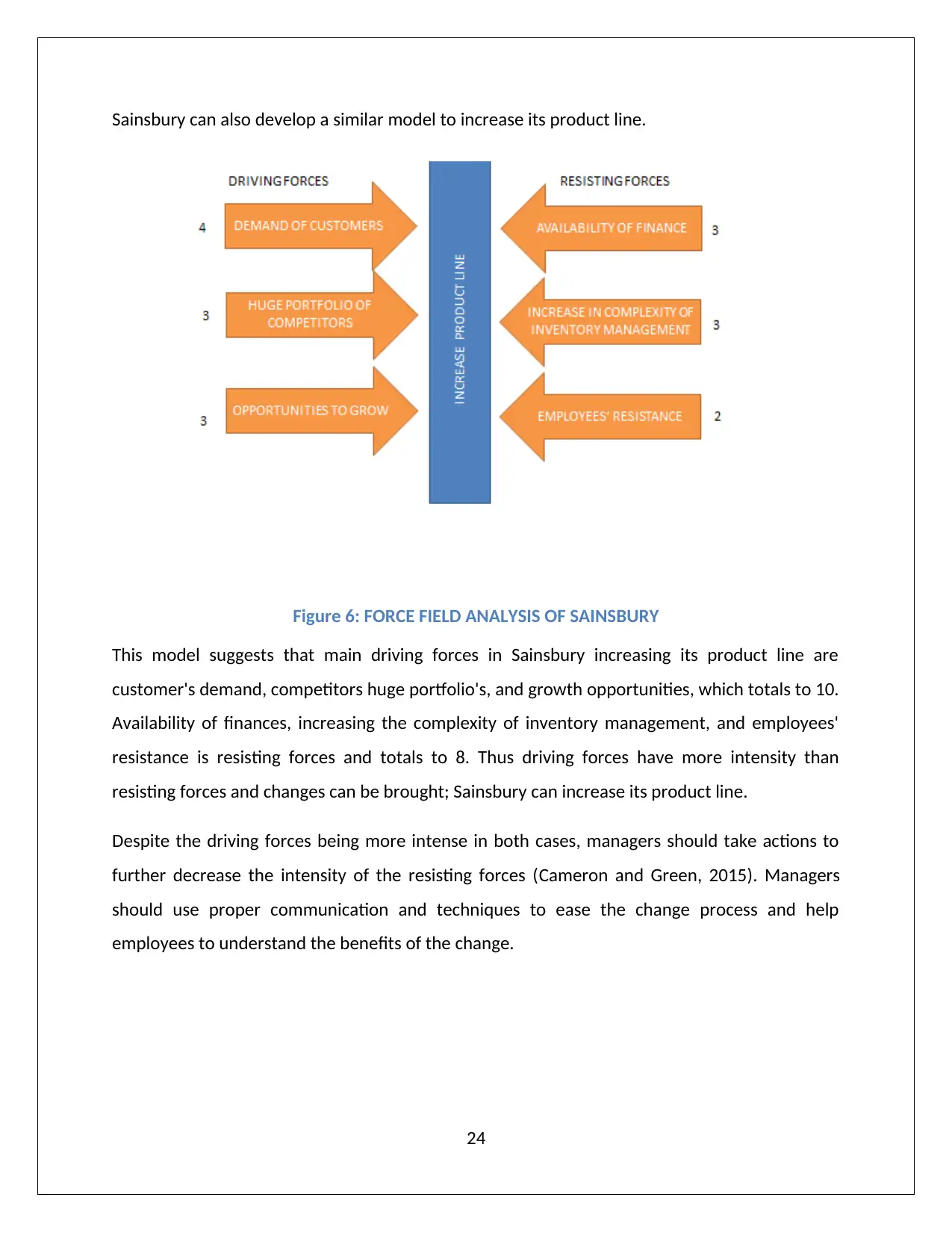
Sainsbury can also develop a similar model to increase its product line.
Figure 6: FORCE FIELD ANALYSIS OF SAINSBURY
This model suggests that main driving forces in Sainsbury increasing its product line are
customer's demand, competitors huge portfolio's, and growth opportunities, which totals to 10.
Availability of finances, increasing the complexity of inventory management, and employees'
resistance is resisting forces and totals to 8. Thus driving forces have more intensity than
resisting forces and changes can be brought; Sainsbury can increase its product line.
Despite the driving forces being more intense in both cases, managers should take actions to
further decrease the intensity of the resisting forces (Cameron and Green, 2015). Managers
should use proper communication and techniques to ease the change process and help
employees to understand the benefits of the change.
24
Figure 6: FORCE FIELD ANALYSIS OF SAINSBURY
This model suggests that main driving forces in Sainsbury increasing its product line are
customer's demand, competitors huge portfolio's, and growth opportunities, which totals to 10.
Availability of finances, increasing the complexity of inventory management, and employees'
resistance is resisting forces and totals to 8. Thus driving forces have more intensity than
resisting forces and changes can be brought; Sainsbury can increase its product line.
Despite the driving forces being more intense in both cases, managers should take actions to
further decrease the intensity of the resisting forces (Cameron and Green, 2015). Managers
should use proper communication and techniques to ease the change process and help
employees to understand the benefits of the change.
24
Paraphrase This Document
Need a fresh take? Get an instant paraphrase of this document with our AI Paraphraser
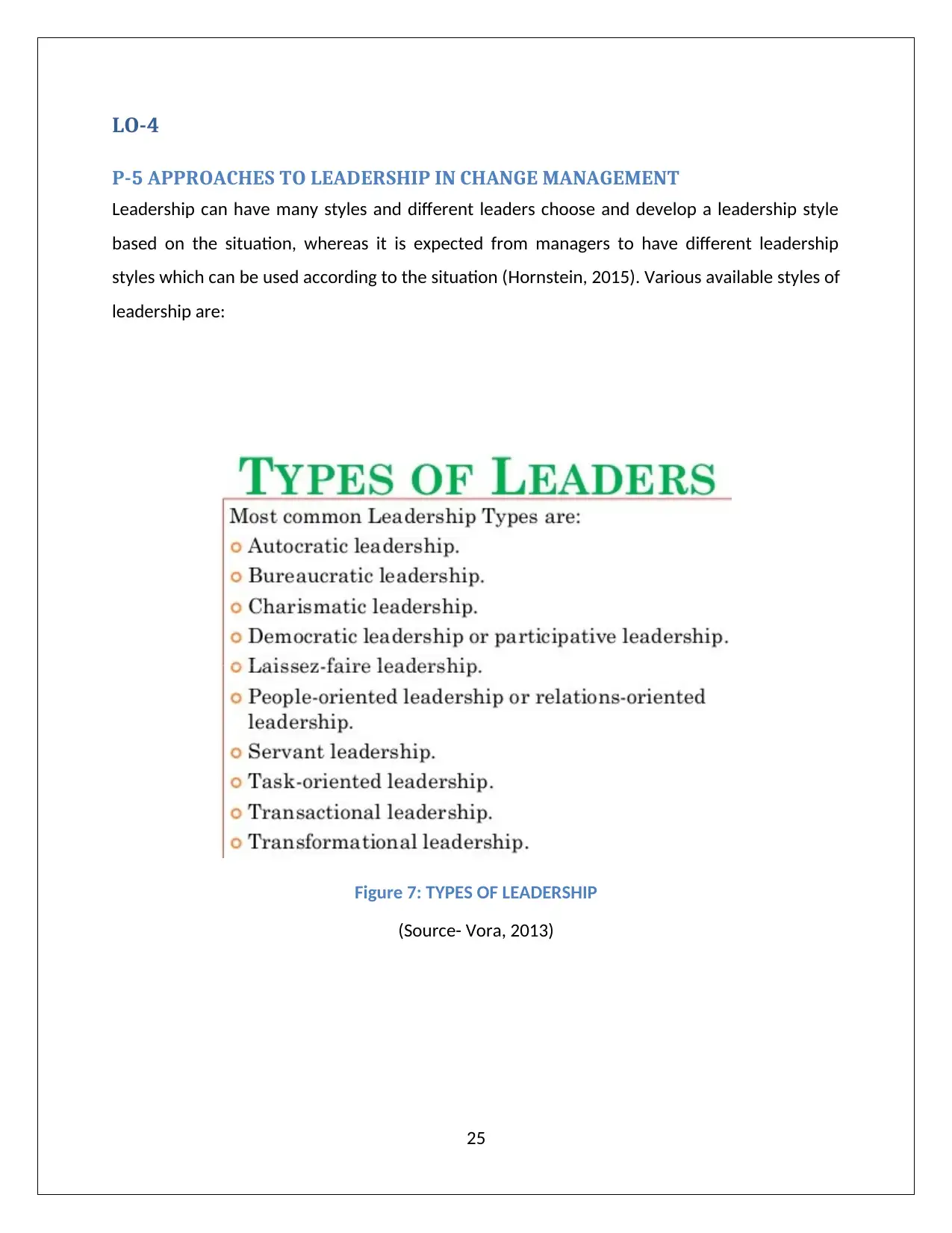
LO-4
P-5 APPROACHES TO LEADERSHIP IN CHANGE MANAGEMENT
Leadership can have many styles and different leaders choose and develop a leadership style
based on the situation, whereas it is expected from managers to have different leadership
styles which can be used according to the situation (Hornstein, 2015). Various available styles of
leadership are:
Figure 7: TYPES OF LEADERSHIP
(Source- Vora, 2013)
25
P-5 APPROACHES TO LEADERSHIP IN CHANGE MANAGEMENT
Leadership can have many styles and different leaders choose and develop a leadership style
based on the situation, whereas it is expected from managers to have different leadership
styles which can be used according to the situation (Hornstein, 2015). Various available styles of
leadership are:
Figure 7: TYPES OF LEADERSHIP
(Source- Vora, 2013)
25

Though there are three primary approaches to leadership which depend upon the control of
manager and degree of importance of employees in decision making (Cameron and Green,
2015).
Figure 8: KEY APPROACHES TO LEADERSHIP
(Source- Benefield, 2017)
Laissez-Faire Leadership:
As per this approach employees have full control over the process of decision making and
manager doesn’t have much involvement (Wong et al., 2019). This approach is best suitable
where managers trust employees to take effective decisions in the change-making process and
is most common in the artistic field. Tesco and Sainsbury can use this approach in delivering
change in top management since every departmental head will now best for his department
and organization.
Democratic Leadership:
As per this approach employees are highly involved in the decision making. Here leaders
encourage more discussion to obtain various viewpoints which can result in best decision
26
manager and degree of importance of employees in decision making (Cameron and Green,
2015).
Figure 8: KEY APPROACHES TO LEADERSHIP
(Source- Benefield, 2017)
Laissez-Faire Leadership:
As per this approach employees have full control over the process of decision making and
manager doesn’t have much involvement (Wong et al., 2019). This approach is best suitable
where managers trust employees to take effective decisions in the change-making process and
is most common in the artistic field. Tesco and Sainsbury can use this approach in delivering
change in top management since every departmental head will now best for his department
and organization.
Democratic Leadership:
As per this approach employees are highly involved in the decision making. Here leaders
encourage more discussion to obtain various viewpoints which can result in best decision
26
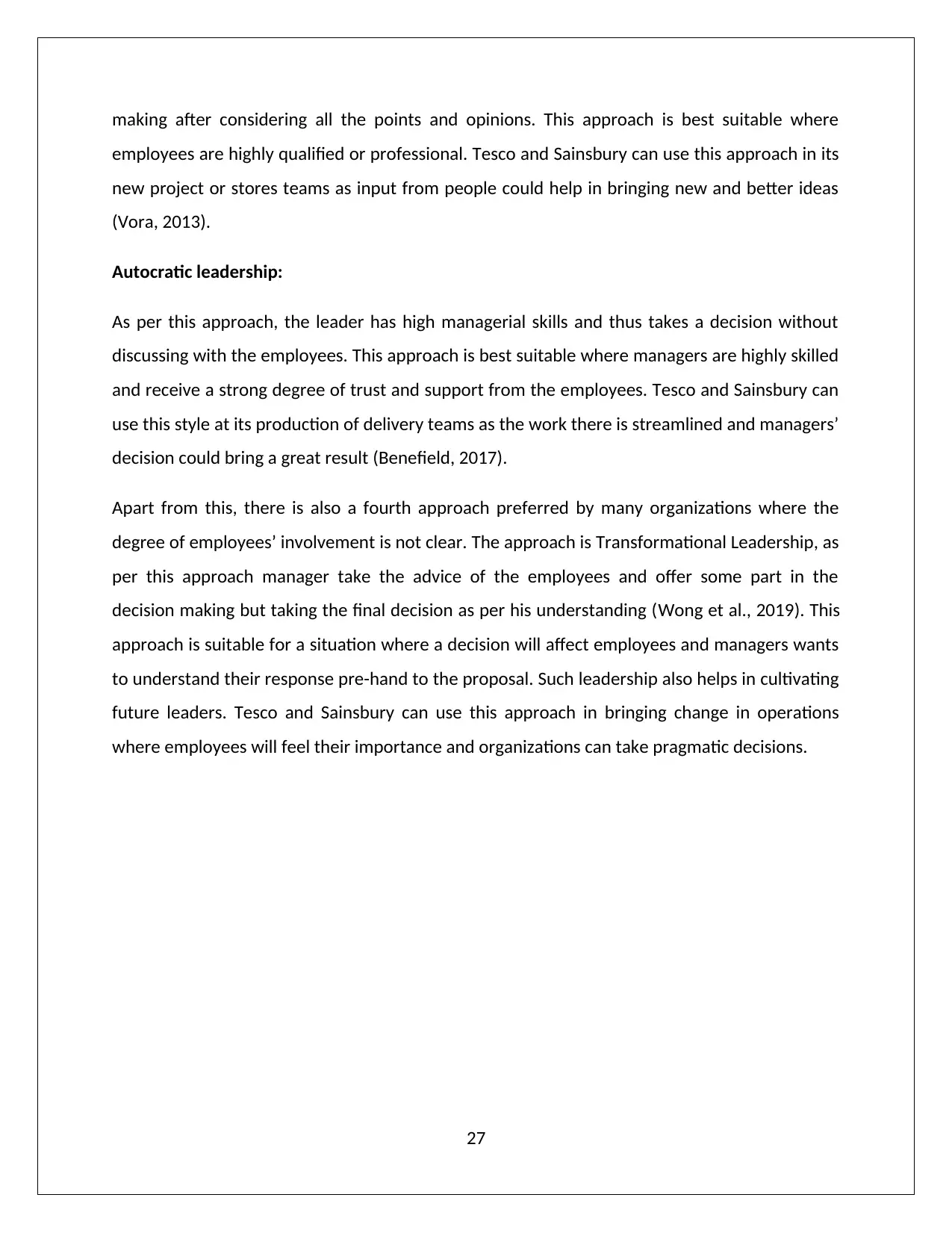
making after considering all the points and opinions. This approach is best suitable where
employees are highly qualified or professional. Tesco and Sainsbury can use this approach in its
new project or stores teams as input from people could help in bringing new and better ideas
(Vora, 2013).
Autocratic leadership:
As per this approach, the leader has high managerial skills and thus takes a decision without
discussing with the employees. This approach is best suitable where managers are highly skilled
and receive a strong degree of trust and support from the employees. Tesco and Sainsbury can
use this style at its production of delivery teams as the work there is streamlined and managers’
decision could bring a great result (Benefield, 2017).
Apart from this, there is also a fourth approach preferred by many organizations where the
degree of employees’ involvement is not clear. The approach is Transformational Leadership, as
per this approach manager take the advice of the employees and offer some part in the
decision making but taking the final decision as per his understanding (Wong et al., 2019). This
approach is suitable for a situation where a decision will affect employees and managers wants
to understand their response pre-hand to the proposal. Such leadership also helps in cultivating
future leaders. Tesco and Sainsbury can use this approach in bringing change in operations
where employees will feel their importance and organizations can take pragmatic decisions.
27
employees are highly qualified or professional. Tesco and Sainsbury can use this approach in its
new project or stores teams as input from people could help in bringing new and better ideas
(Vora, 2013).
Autocratic leadership:
As per this approach, the leader has high managerial skills and thus takes a decision without
discussing with the employees. This approach is best suitable where managers are highly skilled
and receive a strong degree of trust and support from the employees. Tesco and Sainsbury can
use this style at its production of delivery teams as the work there is streamlined and managers’
decision could bring a great result (Benefield, 2017).
Apart from this, there is also a fourth approach preferred by many organizations where the
degree of employees’ involvement is not clear. The approach is Transformational Leadership, as
per this approach manager take the advice of the employees and offer some part in the
decision making but taking the final decision as per his understanding (Wong et al., 2019). This
approach is suitable for a situation where a decision will affect employees and managers wants
to understand their response pre-hand to the proposal. Such leadership also helps in cultivating
future leaders. Tesco and Sainsbury can use this approach in bringing change in operations
where employees will feel their importance and organizations can take pragmatic decisions.
27
Secure Best Marks with AI Grader
Need help grading? Try our AI Grader for instant feedback on your assignments.
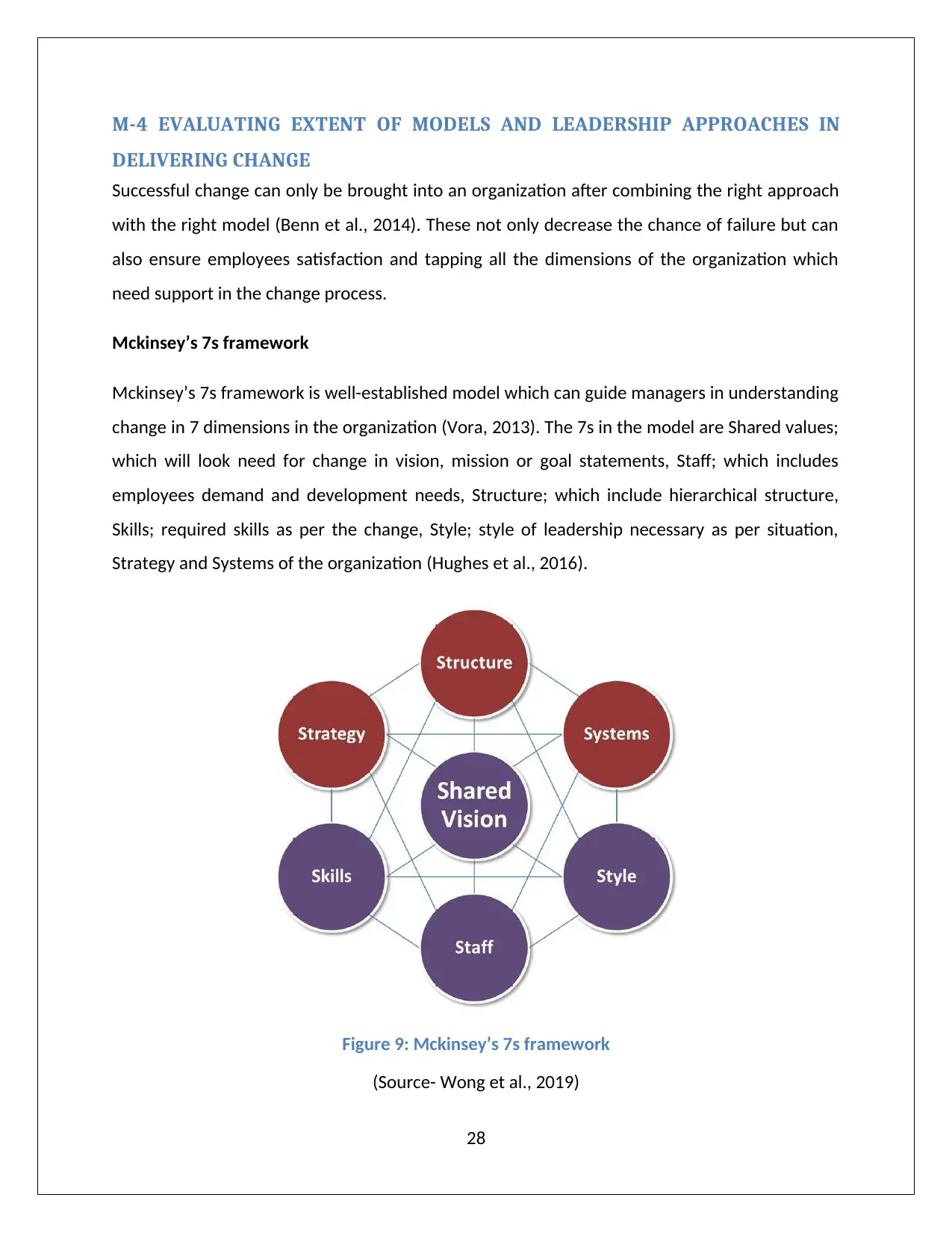
M-4 EVALUATING EXTENT OF MODELS AND LEADERSHIP APPROACHES IN
DELIVERING CHANGE
Successful change can only be brought into an organization after combining the right approach
with the right model (Benn et al., 2014). These not only decrease the chance of failure but can
also ensure employees satisfaction and tapping all the dimensions of the organization which
need support in the change process.
Mckinsey’s 7s framework
Mckinsey’s 7s framework is well-established model which can guide managers in understanding
change in 7 dimensions in the organization (Vora, 2013). The 7s in the model are Shared values;
which will look need for change in vision, mission or goal statements, Staff; which includes
employees demand and development needs, Structure; which include hierarchical structure,
Skills; required skills as per the change, Style; style of leadership necessary as per situation,
Strategy and Systems of the organization (Hughes et al., 2016).
Figure 9: Mckinsey’s 7s framework
(Source- Wong et al., 2019)
28
DELIVERING CHANGE
Successful change can only be brought into an organization after combining the right approach
with the right model (Benn et al., 2014). These not only decrease the chance of failure but can
also ensure employees satisfaction and tapping all the dimensions of the organization which
need support in the change process.
Mckinsey’s 7s framework
Mckinsey’s 7s framework is well-established model which can guide managers in understanding
change in 7 dimensions in the organization (Vora, 2013). The 7s in the model are Shared values;
which will look need for change in vision, mission or goal statements, Staff; which includes
employees demand and development needs, Structure; which include hierarchical structure,
Skills; required skills as per the change, Style; style of leadership necessary as per situation,
Strategy and Systems of the organization (Hughes et al., 2016).
Figure 9: Mckinsey’s 7s framework
(Source- Wong et al., 2019)
28
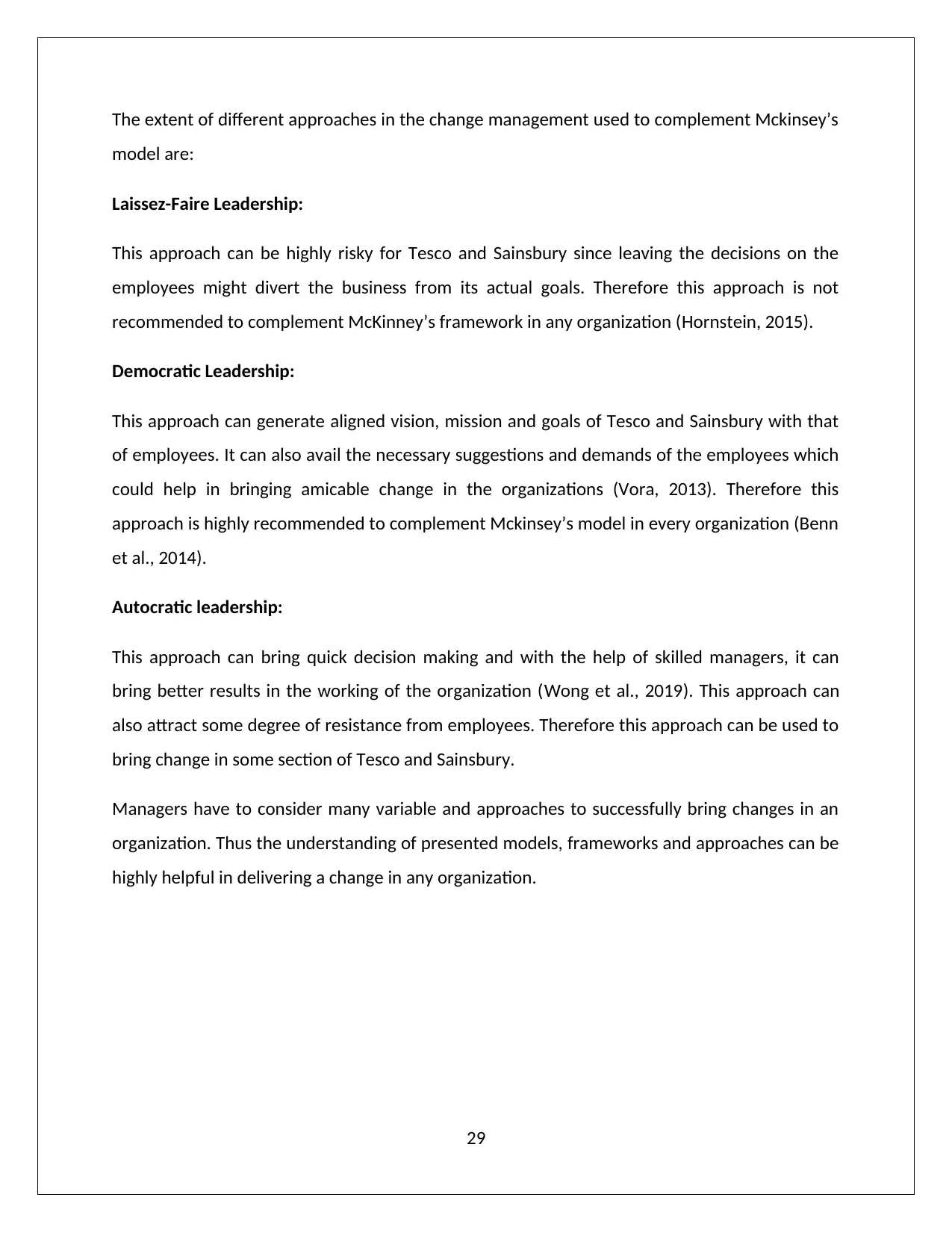
The extent of different approaches in the change management used to complement Mckinsey’s
model are:
Laissez-Faire Leadership:
This approach can be highly risky for Tesco and Sainsbury since leaving the decisions on the
employees might divert the business from its actual goals. Therefore this approach is not
recommended to complement McKinney’s framework in any organization (Hornstein, 2015).
Democratic Leadership:
This approach can generate aligned vision, mission and goals of Tesco and Sainsbury with that
of employees. It can also avail the necessary suggestions and demands of the employees which
could help in bringing amicable change in the organizations (Vora, 2013). Therefore this
approach is highly recommended to complement Mckinsey’s model in every organization (Benn
et al., 2014).
Autocratic leadership:
This approach can bring quick decision making and with the help of skilled managers, it can
bring better results in the working of the organization (Wong et al., 2019). This approach can
also attract some degree of resistance from employees. Therefore this approach can be used to
bring change in some section of Tesco and Sainsbury.
Managers have to consider many variable and approaches to successfully bring changes in an
organization. Thus the understanding of presented models, frameworks and approaches can be
highly helpful in delivering a change in any organization.
29
model are:
Laissez-Faire Leadership:
This approach can be highly risky for Tesco and Sainsbury since leaving the decisions on the
employees might divert the business from its actual goals. Therefore this approach is not
recommended to complement McKinney’s framework in any organization (Hornstein, 2015).
Democratic Leadership:
This approach can generate aligned vision, mission and goals of Tesco and Sainsbury with that
of employees. It can also avail the necessary suggestions and demands of the employees which
could help in bringing amicable change in the organizations (Vora, 2013). Therefore this
approach is highly recommended to complement Mckinsey’s model in every organization (Benn
et al., 2014).
Autocratic leadership:
This approach can bring quick decision making and with the help of skilled managers, it can
bring better results in the working of the organization (Wong et al., 2019). This approach can
also attract some degree of resistance from employees. Therefore this approach can be used to
bring change in some section of Tesco and Sainsbury.
Managers have to consider many variable and approaches to successfully bring changes in an
organization. Thus the understanding of presented models, frameworks and approaches can be
highly helpful in delivering a change in any organization.
29
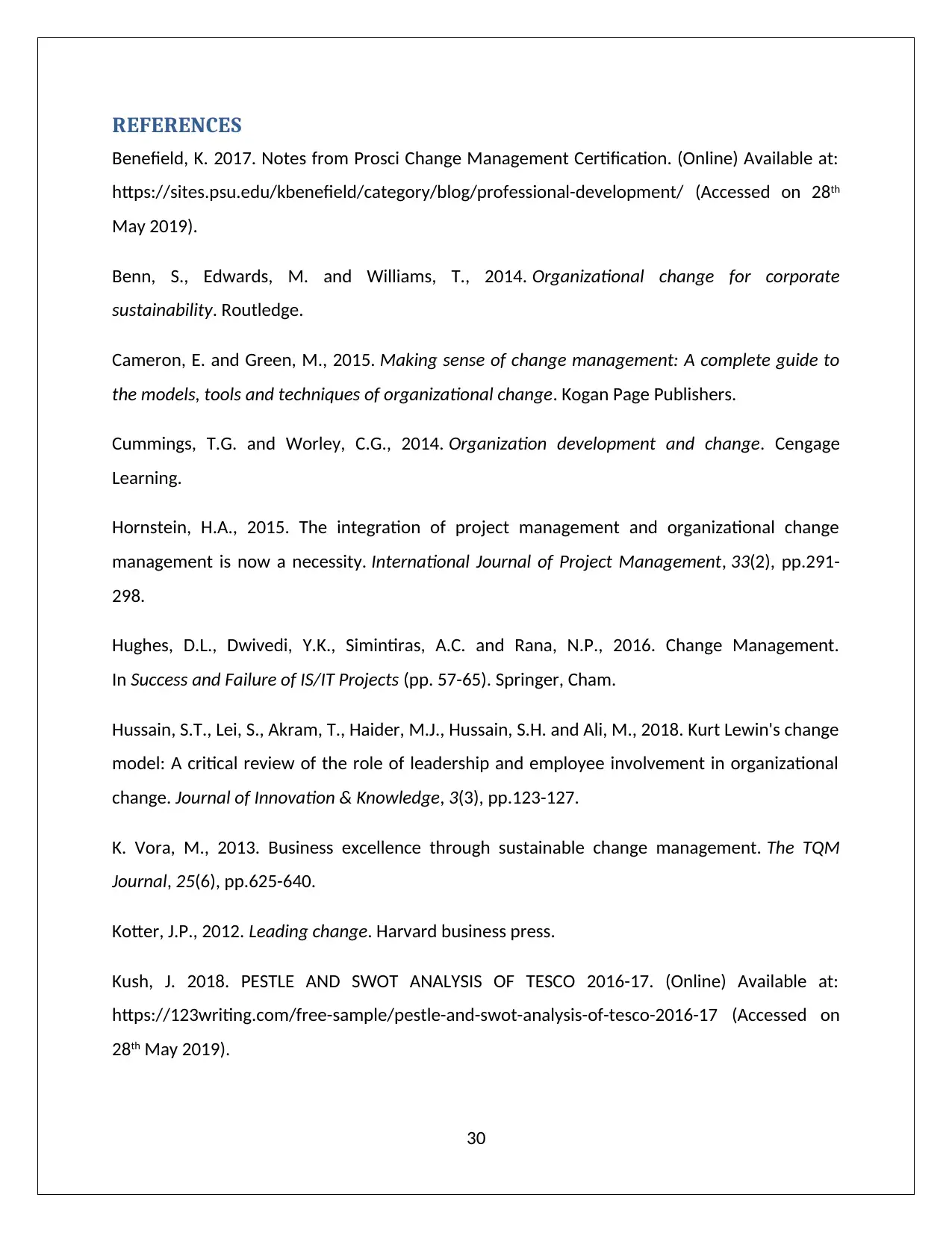
REFERENCES
Benefield, K. 2017. Notes from Prosci Change Management Certification. (Online) Available at:
https://sites.psu.edu/kbenefield/category/blog/professional-development/ (Accessed on 28th
May 2019).
Benn, S., Edwards, M. and Williams, T., 2014. Organizational change for corporate
sustainability. Routledge.
Cameron, E. and Green, M., 2015. Making sense of change management: A complete guide to
the models, tools and techniques of organizational change. Kogan Page Publishers.
Cummings, T.G. and Worley, C.G., 2014. Organization development and change. Cengage
Learning.
Hornstein, H.A., 2015. The integration of project management and organizational change
management is now a necessity. International Journal of Project Management, 33(2), pp.291-
298.
Hughes, D.L., Dwivedi, Y.K., Simintiras, A.C. and Rana, N.P., 2016. Change Management.
In Success and Failure of IS/IT Projects (pp. 57-65). Springer, Cham.
Hussain, S.T., Lei, S., Akram, T., Haider, M.J., Hussain, S.H. and Ali, M., 2018. Kurt Lewin's change
model: A critical review of the role of leadership and employee involvement in organizational
change. Journal of Innovation & Knowledge, 3(3), pp.123-127.
K. Vora, M., 2013. Business excellence through sustainable change management. The TQM
Journal, 25(6), pp.625-640.
Kotter, J.P., 2012. Leading change. Harvard business press.
Kush, J. 2018. PESTLE AND SWOT ANALYSIS OF TESCO 2016-17. (Online) Available at:
https://123writing.com/free-sample/pestle-and-swot-analysis-of-tesco-2016-17 (Accessed on
28th May 2019).
30
Benefield, K. 2017. Notes from Prosci Change Management Certification. (Online) Available at:
https://sites.psu.edu/kbenefield/category/blog/professional-development/ (Accessed on 28th
May 2019).
Benn, S., Edwards, M. and Williams, T., 2014. Organizational change for corporate
sustainability. Routledge.
Cameron, E. and Green, M., 2015. Making sense of change management: A complete guide to
the models, tools and techniques of organizational change. Kogan Page Publishers.
Cummings, T.G. and Worley, C.G., 2014. Organization development and change. Cengage
Learning.
Hornstein, H.A., 2015. The integration of project management and organizational change
management is now a necessity. International Journal of Project Management, 33(2), pp.291-
298.
Hughes, D.L., Dwivedi, Y.K., Simintiras, A.C. and Rana, N.P., 2016. Change Management.
In Success and Failure of IS/IT Projects (pp. 57-65). Springer, Cham.
Hussain, S.T., Lei, S., Akram, T., Haider, M.J., Hussain, S.H. and Ali, M., 2018. Kurt Lewin's change
model: A critical review of the role of leadership and employee involvement in organizational
change. Journal of Innovation & Knowledge, 3(3), pp.123-127.
K. Vora, M., 2013. Business excellence through sustainable change management. The TQM
Journal, 25(6), pp.625-640.
Kotter, J.P., 2012. Leading change. Harvard business press.
Kush, J. 2018. PESTLE AND SWOT ANALYSIS OF TESCO 2016-17. (Online) Available at:
https://123writing.com/free-sample/pestle-and-swot-analysis-of-tesco-2016-17 (Accessed on
28th May 2019).
30
Paraphrase This Document
Need a fresh take? Get an instant paraphrase of this document with our AI Paraphraser

Langley, A.N.N., Smallman, C., Tsoukas, H. and Van de Ven, A.H., 2013. Process studies of
change in organization and management: Unveiling temporality, activity, and flow. Academy of
management journal, 56(1), pp.1-13.
Rajan, R. and Ganesan, R., 2017. A critical analysis of John P. Kotter's change management
framework. Asian Journal of Research in Business Economics and Management, 7(7), pp.181-
203.
Sainsbury, 2019. About. (Online) Available at:
https://www.about.sainsburys.co.uk/about-us/our-vision (Accessed on 28th May 2019).
Smith, C. 2015. 5 Barriers to Change Management and How to Easily Overcome Them. (Online)
Available at: https://change.walkme.com/5-barriers-to-change-management-and-how-to-
easily-overcome-them/ (Accessed on 28th May 2019).
Smith, C. 2017. Barriers To Organizational Change. (Online) Available at:
https://change.walkme.com/4-barriers-to-organizational-change/ (Accessed on 28th May 2018).
Tesco, 2019. History. (Online) Available at: https://www.tescoplc.com/about-us/history/
(Accessed on 28th May 2019).
Thakur, S. 2019. Using the Burke-Litwin Change Model to Manage Organizational Change.
(Online) Available at: https://www.brighthubpm.com/change-management/86867-explaining-
the-burke-litwin-change-model/ (Accessed on 28th May 2019).
Wong, Q., Lacombe, M., Keller, R., Joyce, T. and O'Malley, K., 2019. Leading change with
ADKAR. Nursing management, 50(4), pp.28-35.
31
change in organization and management: Unveiling temporality, activity, and flow. Academy of
management journal, 56(1), pp.1-13.
Rajan, R. and Ganesan, R., 2017. A critical analysis of John P. Kotter's change management
framework. Asian Journal of Research in Business Economics and Management, 7(7), pp.181-
203.
Sainsbury, 2019. About. (Online) Available at:
https://www.about.sainsburys.co.uk/about-us/our-vision (Accessed on 28th May 2019).
Smith, C. 2015. 5 Barriers to Change Management and How to Easily Overcome Them. (Online)
Available at: https://change.walkme.com/5-barriers-to-change-management-and-how-to-
easily-overcome-them/ (Accessed on 28th May 2019).
Smith, C. 2017. Barriers To Organizational Change. (Online) Available at:
https://change.walkme.com/4-barriers-to-organizational-change/ (Accessed on 28th May 2018).
Tesco, 2019. History. (Online) Available at: https://www.tescoplc.com/about-us/history/
(Accessed on 28th May 2019).
Thakur, S. 2019. Using the Burke-Litwin Change Model to Manage Organizational Change.
(Online) Available at: https://www.brighthubpm.com/change-management/86867-explaining-
the-burke-litwin-change-model/ (Accessed on 28th May 2019).
Wong, Q., Lacombe, M., Keller, R., Joyce, T. and O'Malley, K., 2019. Leading change with
ADKAR. Nursing management, 50(4), pp.28-35.
31
1 out of 32
Related Documents
Your All-in-One AI-Powered Toolkit for Academic Success.
+13062052269
info@desklib.com
Available 24*7 on WhatsApp / Email
![[object Object]](/_next/static/media/star-bottom.7253800d.svg)
Unlock your academic potential
© 2024 | Zucol Services PVT LTD | All rights reserved.





